先住民の文化的再構成
cultural re-structuring of idigenous people
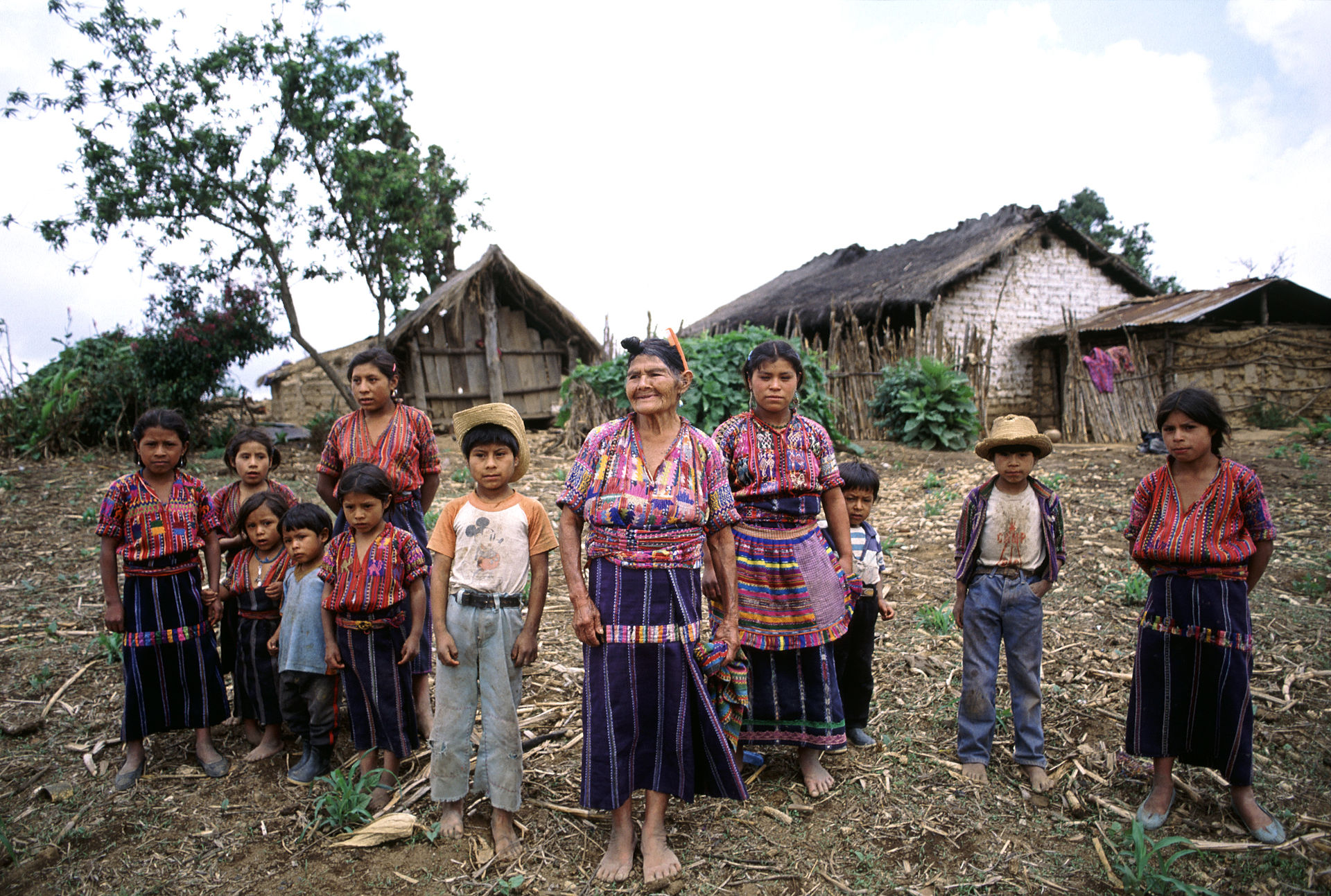
先住民の文化的再構成
cultural re-structuring of idigenous people

A Kaqchikel family in the hamlet of Patzutzun, Guatemala, 1993;
1993年、グアテマラ、パツツンの集落のカクチケル一家
■文化的再構成(cultural re-structuring)
国 家的暴力やグローバル経済による経済搾取から、いったんデラシネになった移民たちが、マヤ先住民ないしはグアテマラ国民として自己アイデンティティを再構 成(=改造)して、それに見合った 文化構造を構成する試みを、文化的再構成(cultural re-structuring)と呼ぼう。そこでは人々が、伝統的な柵(しがらみ)から自由——もちろん完全な自由ではない——になり、自分たちの文化要 素の取捨選択や再解釈が可能になり、文化が参与者の合意をもとに構成されることになる。
文 化的再構成は、文化の再創造の過程の一つである。ただし、ボブスボームらの言う再創造に含まれているような正統的文化の継承者による正統的 過去の捏造過程という詳細な正当化のプロセスよりも、ここでは当事者たち(=文化の再構成者)が抱いているユートピア的状況の構成プロセスがあり、そのプ ロセスにおいては当事者の間の意見は交渉可能で、未来予測がしにくい、開発途上のものである。
◎ウィキペディア(英語)による先住民あ
るいは先住の民(Indigenous
peoples)の解説の翻訳。
| Indigenous
peoples Indigenous peoples[a] are the earliest known inhabitants of an area and their descendants, especially one that has been colonized by a now-dominant group of settlers. However, the term lacks a single, authoritative definition[1] and can be used to describe a variety of peoples and cultures.[2][3] In its modern context, the term Indigenous was first used by Europeans, who used it to differentiate the Indigenous peoples of the Americas from the European settlers of the Americas, as well as from the sub-Saharan Africans the settlers enslaved and brought to the Americas by force. The term may have first been used in this context by Sir Thomas Browne in 1646, who stated "and although in many parts thereof there be at present swarms of Negroes serving under the Spaniard, yet were they all transported from Africa, since the discovery of Columbus; and are not indigenous or proper natives of America."[4][5] Peoples are usually described as "Indigenous" when they maintain traditions or other aspects of an early culture that is associated with the first inhabitants of a given region.[6][failed verification] Not all Indigenous peoples share this characteristic, as many have adopted substantial elements of a colonizing culture, such as dress, religion or language. Indigenous peoples may be settled in a given region (sedentary), exhibit a nomadic lifestyle across a large territory, or be resettled, but they are generally historically associated with a specific territory on which they depend. Indigenous societies are found in every inhabited climate zone and continent of the world except Antarctica.[7] There are approximately five thousand Indigenous nations throughout the world.[8] Indigenous peoples' homelands have historically been colonized by larger ethnic groups, who justified colonization with beliefs of racial and religious superiority, land use or economic opportunity.[9] Thousands of Indigenous nations throughout the world currently live in countries where they are not a majority ethnic group.[10] Indigenous peoples continue to face threats to their sovereignty, economic well-being, languages, ways of knowing, and access to the resources on which their cultures depend. Indigenous rights have been set forth in international law by the United Nations, the International Labour Organization, and the World Bank.[11] In 2007, the UN issued a Declaration on the Rights of Indigenous Peoples (UNDRIP) to guide member-state national policies to the collective rights of Indigenous peoples, including their rights to protect their cultures, identities, languages, ceremonies, and access to employment, health, education and natural resources.[12] Estimates of the total global population of Indigenous peoples usually range from 250 million to 600 million.[13] Official designations and terminology of who is considered Indigenous vary between countries, ethnic groups and other factors.[2] In the Americas, Australia and New Zealand, Indigenous status is often applied unproblematically to groups descended from the peoples who lived there prior to European settlement. However, In Asia and Africa, definitions of Indigenous status have been either rejected by certain peoples,[14] or applied to minorities and or oppressed peoples, who may not be considered "Indigenous" in other contexts.[15] Thus, population figures are less clear and may fluctuate dramatically.[2] The concept of indigenous peoples is rarely used in Europe, where very few indigenous groups are recognized, with the exception of groups such as the Sámi.[16] |
先
住民 先住民[a]とは、ある地域の最古の住民とその子孫のことであり、特に 現在支配的な入植者グループによって植民地化された地域を指す。しかし、この用語は単一の権威ある定義[1]を欠いており、様々な民族や文化を表現するた めに使用されることがある[2][3]。現代的な文脈では、先住民という用語はヨーロッパ人によって最初に使用され、彼らはアメリカ大陸の先住民を、アメ リカ大陸のヨーロッパ人入植者や、入植者が奴隷として強制的にアメリカ大陸に連れてきたサハラ以南のアフリカ人と区別するために使用した。この言葉は 1646年にトーマス・ブラウン卿によって初めてこの文脈で使用されたと思われ、彼は「現在その多くの地域ではスペイン人の下で働く黒人の大群がいるが、 コロンブスの発見以来、彼らはすべてアフリカから輸送されたものであり、アメリカの先住民でもなければ、正真正銘の原住民でもない」と述べている[4] [5]。 人びと(人民)が通常、特定の地域の最初の住民に関連する伝統や初期の文化の他の側面を維持している場合、「先住民」と表現される[6][検証失敗]。服 装、宗教、言語など、植民地化した文化の実質的な要素を取り入れているものも多いため、すべての先住民がこの特徴を共有しているわけではない。先住民は特 定の地域に定住することもあれば(定住)、広大な領土で遊牧生活を送ることもあり、また再定住することもあるが、一般的に歴史的に特定の領土と結びついて おり、その領土に依存している。先住民社会は、南極大陸を除く世界のすべての居住気候と大陸に存在する[7]。 先住民の居住地は歴史的に大きな民族グループによって植民地化されてきた。彼らは人種的、宗教的優越性、土地利用、経済的機会などの信念をもって植民地化 を正当化してきた[9]。現在、世界中の何千もの先住民族国家が、彼らが多数民族グループではない国に住んでいる[10]。2007年、国連は先住民族の 権利に関する宣言(UNDRIP)を発表し、文化、アイデンティティ、言語、儀式、雇用、健康、教育、天然資源へのアクセスを保護する権利を含む、先住民 族の集団的権利に対する加盟国の国内政策の指針としている[12]。 先住民の世界総人口の推定は、通常2億5000万人から6億人の範囲にある[13]。誰が先住民族とみなされるかについての公式の呼称や用語は、国や民族 グループ、その他の要因によって異なる[2]。アメリカ大陸、オーストラリア、ニュージーランドでは、先住民族の地位は、ヨーロッパ人が入植する前にそこ に住んでいた民族の末裔のグループに問題なく適用されることが多い。しかし、アジアやアフリカでは、先住民の地位の定義は、特定の民族によって拒否された り[14]、少数民族や抑圧された民族に適用されたりしており、他の文脈では「先住民」とはみなされないこともある[15]。そのため、人口の数値は明確 ではなく、劇的に変動することがある[2]。先住民の概念は、サーメのような集団を除いて、先住民集団がほとんど認められていないヨーロッパではほとんど 使用されていない[16]。 |
| Etymology Indigenous is derived from the Latin word indigena, meaning "sprung from the land, native".[17] The Latin indigena is based on the Old Latin indu "in, within" + gignere "to beget, produce". Indu is an extended form of the Proto-Indo-European en or "in".[18] The origins of the term Indigenous, used to describe people, are not related in any way to the origins of the term Indian, which has also been applied to Indigenous peoples of the Americas.[19] Autochthonous originates from the Greek αὐτός autós meaning self/own, and χθών chthon meaning Earth. The term is based in the Indo-European root dhghem- (earth). The earliest documented use of this term was in 1804.[20] |
語源 インディヘナ(Indigenous)はラテン語のインディヘナ(indigena)に由来し、「土地から生まれた、土着の」という意味である[17]。 ラテン語のインディヘナは古ラテン語のindu「中に、内に」+gignere「生む、生み出す」に基づいている。先住民という用語の起源は、アメリカ大 陸の先住民にも適用されているインディアンという用語の起源とは無関係である[19]。 Autochthonousの語源はギリシャ語のαŐτός autós(自己/所有)とχθών chthon(地球)に由来する。この語はインド・ヨーロッパ語の語源dhghem-(大地)に基づく。この用語の最古の使用記録は1804年である [20]。 |
Definitions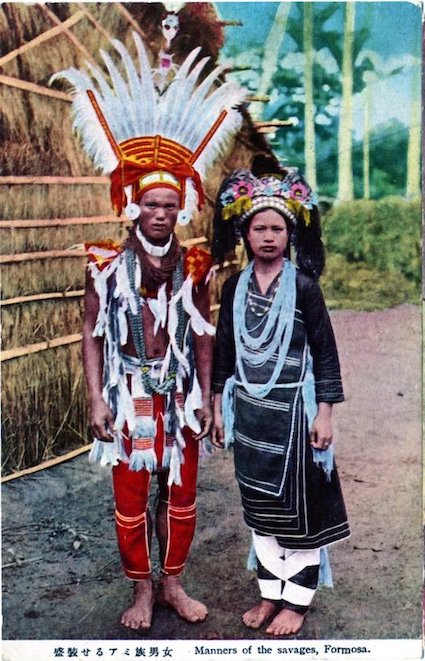 Colorized photograph of an Amis couple in traditional clothing. Taken in pre-World War II Japanese-ruled Taiwan. As a reference to a group of people, the term Indigenous first came into use by Europeans who used it to differentiate the Indigenous peoples of the Americas from enslaved Africans. It may have first been used in this context by Sir Thomas Browne. In Chapter 10 of Pseudodoxia Epidemica (1646), entitled "Of the Blackness of Negroes", Browne wrote "and although in many parts thereof there be at present swarms of Negroes serving under the Spaniard, yet were they all transported from Africa, since the discovery of Columbus; and are not indigenous or proper natives of America."[4][5] In the 1970s, the term was used as a way of linking the experiences, issues, and struggles of groups of colonized people across international borders. At this time 'indigenous people(s)' also began to be used to describe a legal category in Indigenous law created in international and national legislation. The use of the 's' in 'peoples' recognizes that there are real differences between different Indigenous peoples.[21][22] James Anaya, former Special Rapporteur on the Rights of Indigenous Peoples, defined Indigenous peoples as "living descendants of pre-invasion inhabitants of lands now dominated by others. They are culturally distinct groups that find themselves engulfed by other settler societies born of forces of empire and conquest".[23][24] National definitions Throughout history, different nations have used a variety of terms to describe the groups within their boundaries that they recognize as Indigenous. Definitions are usually based on a peoples' descent from populations that have historically inhabited the country prior to the time when peoples from non-Indigenous cultures and religions arrived – or at the establishment of present state boundaries – who retain some or all of their own social, economic, cultural and political institutions, but who may have been displaced from their traditional domains or who may have resettled outside their ancestral domains.[25] The status of the Indigenous groups in the subjugated relationship can be characterized in most instances as an effectively marginalized or isolated group, in comparison to majority groups or the nation-state as a whole.[26] The Indigenous group's ability to influence and participate in the external policies that may exercise jurisdiction over their traditional lands and practices is very frequently limited. This situation can persist even in the case where the Indigenous population outnumbers that of the other inhabitants of the region or state; the defining notion here is one of separation from decision and regulatory processes that have some, at least titular, influence over aspects of their community and land rights.[27] The presence of external laws, claims and cultural mores either potentially or actually act to variously constrain the practices and observances of an Indigenous society. These constraints can be observed even when the Indigenous society is regulated largely by its own tradition and custom. The constraints may be purposefully imposed, or arise as unintended consequence of trans-cultural interaction. They may have a measurable effect, even where countered by other external influences and actions deemed beneficial or that promote Indigenous rights and interests.[25] United Nations 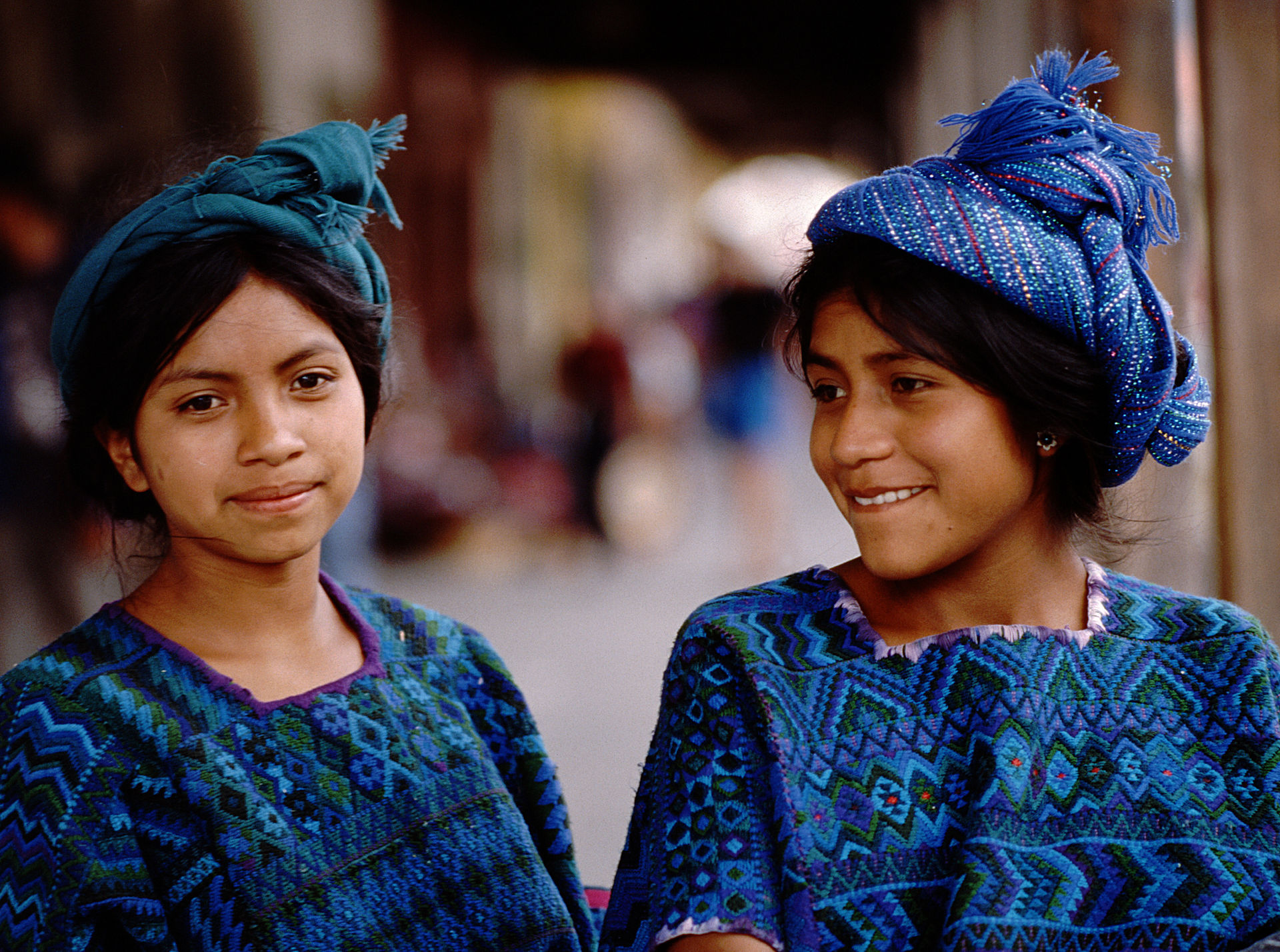 Guatemalan girls in their traditional clothing from the town of Santa Catarina Palopó on Lake Atitlán The International Labour Organization's Indigenous and Tribal Populations Convention, 1957 referred to both "indigenous" and "tribal" people. It refers to people "regarded as indigenous on account of their descent from the populations which inhabited the country, or a geographical region to which the country belongs, at the time of conquest or colonisation". When the convention was revised in 1989, as the Indigenous and Tribal Peoples Convention, 1989, it defined indigenous peoples as: peoples in independent countries who are regarded as indigenous on account of their descent from the populations which inhabited the country, or a geographical region to which the country belongs, at the time of conquest or colonisation or the establishment of present state boundaries and who, irrespective of their legal status, retain some or all of their own social, economic, cultural and political institutions.[28] The first meeting of the United Nations Working Group on Indigenous Populations (WGIP) was on 9 August 1982 and this date is now celebrated as the International Day of the World's Indigenous Peoples.[29] In 1982 the group accepted a preliminary definition by José R. Martínez-Cobo, Special Rapporteur on Discrimination against Indigenous Populations:[30] Indigenous communities, peoples, and nations are those that, having a historical continuity with pre-invasion and pre-colonial societies that developed on their territories, consider themselves distinct from other sectors of the societies now prevailing in those territories, or parts of them. They form at present non-dominant sectors of society and are determined to preserve, develop, and transmit to future generations their ancestral territories, and their ethnic identity, as the basis of their continued existence as peoples, in accordance with their own cultural patterns, social institutions and legal systems.[31] The primary impetus in considering Indigenous identity comes from considering the historical impacts of European colonialism. A 2009 United Nations report published by the Secretariat of the Permanent Forum on Indigenous Issues stated:[32] For centuries, since the time of their colonization, conquest or occupation, Indigenous peoples have documented histories of resistance, interface or cooperation with states, thus demonstrating their conviction and determination to survive with their distinct sovereign identities. Indeed, Indigenous peoples were often recognized as sovereign peoples by states, as witnessed by the hundreds of treaties concluded between Indigenous peoples and the governments of the United States, Canada, New Zealand and others. And yet as Indigenous populations dwindled, and the settler populations grew ever more dominant, states became less and less inclined to recognize the sovereignty of Indigenous peoples. Indigenous peoples themselves, at the same time, continued to adapt to changing circumstances while maintaining their distinct identity as sovereign peoples.[33] The World Health Organization defines Indigenous populations as follows: "communities that live within, or are attached to, geographically distinct traditional habitats or ancestral territories, and who identify themselves as being part of a distinct cultural group, descended from groups present in the area before modern states were created and current borders defined. They generally maintain cultural and social identities, and social, economic, cultural and political institutions, separate from the mainstream or dominant society or culture."[34] |
定義 民族衣装を着たアミ族のカップルのカラー写真。第二次世界大戦前の日本統治下の台湾で撮影された。 先住民(Indigenous)という言葉は、ヨーロッパ人がアメリカ大陸の先住民族を奴隷にされたアフリカ人と区別するために使ったのが始まりである。 この文脈で最初に使われたのは、トーマス・ブラウン卿かもしれない。Pseudodoxia Epidemica』(1646年)の第10章「黒人の黒さについて」と題された中で、ブラウンは「現在、その多くの地域でスペイン人の下で働く黒人の大 群がいるが、コロンブスの発見以来、彼らはすべてアフリカから輸送されたものであり、アメリカの先住民でもなければ適切な原住民でもない」と書いている [4][5]。 1970年代には、この言葉は国際的な国境を越えて、植民地化された人々のグループの経験、問題、闘争を結びつける方法として使われるようになった。この 頃、「先住民族」は、国際法や国内法で作られた先住民法の法的カテゴリーを表す言葉としても使われ始めた。先住民族の権利に関する前特別報告者である ジェームズ・アナヤは、先住民族を「現在他者に支配されている土地の侵略前の住民の生きた子孫」と定義している[21][22]。彼らは文化的に異なる集 団であり、帝国と征服の力によって生まれた他の入植者社会に飲み込まれている」[23][24]。 各国の定義 歴史を通じて、様々な国家が先住民族として認識する境界内の集団を表現するために様々な用語を使用してきた。その定義は通常、非先住民の文化や宗教を持つ 民族が移住してくる以前、あるいは現在の国家境界線が設定された時点で、その国に歴史的に居住していた民族の子孫に基づくものであり、その民族は独自の社 会的、経済的、文化的、政治的制度の一部または全てを保持しているが、伝統的な領域から追い出されたり、先祖伝来の領域外に定住している可能性がある [25]。 被支配関係にある先住民集団の地位は、ほとんどの場合、多数派集団や国民国家全体と比較して、事実上周縁化された、あるいは孤立した集団として特徴づける ことができる[26]。先住民集団が、彼らの伝統的土地や慣習を管轄する可能性のある外部政策に影響を及ぼし、参加する能力は、非常に頻繁に制限されてい る。このような状況は、先住民の人口がその地域や国家の他の住民の人口を上回っている場合であっても持続する可能性がある。ここでの決定的な概念は、彼ら のコミュニティや土地の権利の側面に何らかの、少なくとも暫定的な影響力を持つ決定や規制のプロセスから分離されているというものである[27]。 外部からの法律、主張、文化的風習の存在は、潜在的にも実際にも、先住民社会の実践と遵守を様々に制約するように作用する。こうした制約は、先住民社会が 主として自らの伝統と慣習によって規制されている場合であっても、観察されることがある。こうした制約は、意図的に課されることもあれば、異文化間の相互 作用の意図せざる結果として生じることもある。これらの制約は、有益とみなされる、あるいは先住民の権利と利益を促進する他の外部からの影響や行動によっ て打ち消される場合であっても、測定可能な影響を及ぼすことがある[25]。 国連  アティトラン湖畔のサンタ・カタリーナ・パロポの町の伝統衣装を着たグアテマラの少女たち 1957年の国際労働機関(ILO)の「先住民及び種族人口条約」は、「先住民」と「種族」の両方に言及している。この条約は、「征服または植民地化の時 点で、その国またはその国が属する地理的地域に居住していた集団の子孫であることを理由に、先住民族とみなされる」人々を指す。この条約が1989年に 「1989年先住民族及び部族民条約」として改正された際、先住民族を次のように定義した: 征服もしくは植民地化、または現在の国家境界線が確立された時点で、その国またはその国が属する地理的地域に居住していた住民の子孫であることを理由に先 住民族とみなされ、法的地位にかかわらず、一部またはすべての独自の社会的、経済的、文化的、政治的制度を保持している独立国の人々[28]。 1982年、先住民族に対する差別に関する特別報告者であるホセ・R・マルティネス=コボによる予備的定義を受け入れた[30]。 先住民社会、先住民族、先住民国家とは、その領土で発展した侵略以前および植民地以前の社会との歴史的連続性を持ちながら、それらの領土またはその一部で 現在優勢な社会の他の部門とは区別されていると考えるものである。彼らは現在、社会の非支配的な部門を形成しており、独自の文化様式、社会制度、法制度に 従って、民族としての存続の基礎として、先祖伝来の領土と民族的アイデンティティを保全し、発展させ、後世に伝えることを決意している[31]。 先住民のアイデンティティを考える第一のきっかけは、ヨーロッパ植民地主義の歴史的影響を考慮することにある。先住民族問題に関する常設フォーラム事務局 が2009年に発表した国連の報告書には次のように記されている[32]。 何世紀もの間、植民地化、征服、または占領の時代から、先住民族は国家との抵抗、インターフェース、または協力の歴史を記録してきた。実際、先住民族とア メリカ、カナダ、ニュージーランドなどの政府との間で結ばれた何百もの条約に見られるように、先住民族はしばしば国家から主権民族として認められてきた。 しかし、先住民の人口が減少し、入植者がますます優勢になるにつれ、国家は先住民の主権を認めようとしなくなった。同時に先住民自身も、主権を持つ民族と しての明確なアイデンティティを維持しながら、状況の変化に適応し続けた[33]。 世界保健機関は先住民族を次のように定義している: 地理的に明確な伝統的生息地または先祖伝来の領土内に居住し、またはそこに帰属し、近代国家が創設され現在の国境が定められる以前にその地域に存在した集 団の子孫である明確な文化的集団の一員であることを自認する共同体」。彼らは一般的に、主流または支配的な社会や文化とは別に、文化的・社会的アイデン ティティ、社会的・経済的・文化的・政治的制度を維持している」[34]。 |
| History Classical antiquity Greek sources of the Classical period acknowledge Indigenous people whom they referred to as "Pelasgians". Ancient writers saw these people either as the ancestors of the Greeks,[35] or as an earlier group of people who inhabited Greece before the Greeks.[36] The disposition and precise identity of this former group is elusive, and sources such as Homer, Hesiod and Herodotus give varying, partially mythological accounts. Dionysius of Halicarnassus in his book, Roman Antiquities, gives a synoptic interpretation of the Pelasgians based on the sources available to him then, concluding that Pelasgians were Greek.[37] Greco-Roman society flourished between 330 BCE and 640 CE and undertook successive campaigns of conquest that subsumed more than half of the known world of the time. But because preexisting populations within other parts of Europe at the time of classical antiquity had more in common – culturally speaking – with the Greco-Roman world, the intricacies involved in expansion across the European frontier were not so contentious relative to Indigenous issues.[38][irrelevant citation] In the Middle East during antiquity, there were many nations that rose and fell, leaving no trace in the current day. However, a number of civilizations have continued unabated since ancient times including the Jews, who were indigenous to the Land of Israel and the tiny Samaritan community which lives in the area that still bears its name, Samaria. Africa In European late antiquity, many Berbers, Copts and Nubians of north Africa converted to various forms of Christianity under Roman rule, although elements of traditional religious beliefs were retained.[39] Following the Arab invasions of North Africa in the 7th century, many Berbers were enslaved or recruited into the army. The majority of Berbers, however, remained nomadic pastoralists who also engaged in trade as far as sub-Saharan Africa.[40] Coptic Egyptians remained in possession of their lands and many preserved their language and Christian religion. By the 10th century, however, the majority of the population of north Africa spoke Arabic and practiced Islam.[41] 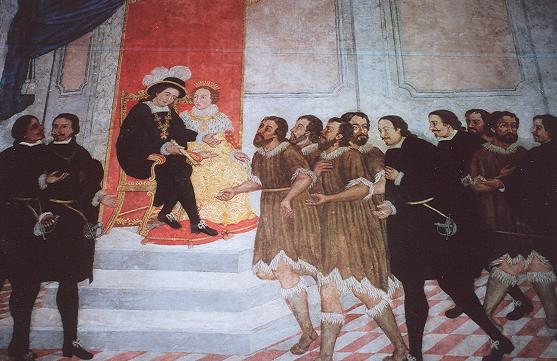 Alonso Fernández de Lugo presenting the captured Guanche kings of Tenerife to Ferdinand and Isabella From 1402, the Guanche of the Canary Islands resisted Spanish attempts at colonization. The islands finally came under Spanish control in 1496. Mohamed Adhikari has called the conquest of the islands a genocide.[42][43] Early 15th-century Portuguese exploration of the west coast of Africa was motivated by a quest for gold and crusading against Islam.[44] Portugal's first attempt at colonization in what is now Senegal ended in failure.[45] In the 1470s, the Portuguese established a fortified trading post on the West coast of Africa, south of the Akan goldfields. The Portuguese engaged in extensive trade of goods for gold and, in later years, slaves for their sugar plantations in the islands off West Africa and in the New World.[46] In 1488, Portuguese ships rounded the Cape of Good Hope[47] and by the 17th century, Portugal had established seaborn trading routes and fortified coastal trading posts from West Africa to India and Southern China, and a settler colony in Brazil.[48] In 1532, the first African slaves were transported directly to the Americas. The trade in slaves expanded sharply in the 17th century, with the involvement of the French, Dutch and English, before declining in the 19th century. At least 12 million slaves were transported from Africa.[49] The slave trade increased inter-tribal warfare and stunted population growth and economic development in the west African interior.[50][51] Americas See also: Age of Discovery Indigenous encounters with Europeans increased during the age of discovery. The Europeans were motivated by a range of factors including trade,[42][52] the exploitation of natural resources,[42][53] spreading Christianity,[54] and establishing strategic military bases, colonies and settlements.[55] From 1492, the Arawak peoples of the Caribbean islands encountered Spanish colonizers initially led by Christopher Columbus. The Spanish enslaved some of the native population and forced others to work on farms and gold mines in a system of labor called ecomienda. Spanish settlements spread from Hispaniola to Puerto Rico, the Bahamas and Cuba, leading to a severe decline in the Indigenous populations from disease, malnutrition, settler violence and cultural disruption.[56][57] In the 1520s, the peoples of Mesoamerica encountered the Spanish who entered their lands in search of gold and other resources. Some indigenous peoples chose to ally with the Spanish to end Aztec rule. The Spanish incursions led to the conquest of Mexico and the end of the Aztec empire. The Cempoalans, Tlaxcalans and other allies of the Spanish were given some autonomy, but the Spanish were de facto rulers of Mexico. Smallpox devastated the indigenous population and aided the Spanish conquest.[58] 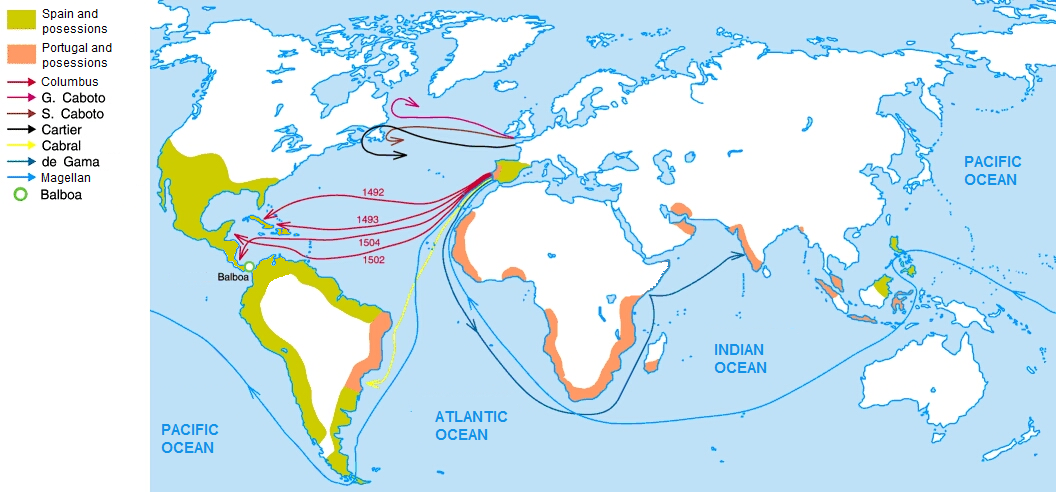 Map with the main travels of the Age of Discovery (which began in the 15th century) In 1530, the Spanish sailed south from Panama to the lands of the Inca Empire in the west of South America. The Inca, weakened by a smallpox epidemic and civil war, were defeated by the Spanish at Cajamarca in 1532, and the emperor Atahualpa was captured and executed. The Spanish appointed a puppet emperor and captured the Inca capital of Cuzco with the support of a number of native peoples. The Spanish established a new capital in 1535 and defeated an Inca rebellion in 1537, thus consolidating the conquest of Peru.[59] In the 1560s, the Spanish established colonies in Florida and in 1598 founded a colony in New Mexico.[60] However, the heartland of the Spanish colonies remained New Spain (including Mexico and most of Central America) and Peru (including most of South America).[61] In the 17th century, French, English and Dutch trading posts multiplied in northern America to exploit whaling, fishing and fur trading. French settlements progressed up the St Lawrence river to the Great Lakes and down the Mississippi to Louisiana.[62] English and Dutch settlements multiplied down the Atlantic coast from modern Massachusetts to Georgia.[63] Native peoples formed alliances with the Europeans in order to promote trade, preserve their autonomy, and gain allies in conflicts with other native peoples.[62][64] However, horses and new weapons made inter-tribal conflicts more deadly and the native population was devastated by introduced diseases. Native peoples also experienced losses from violent conflict with the colonists and the progressive dispossession of their traditional lands.[65] 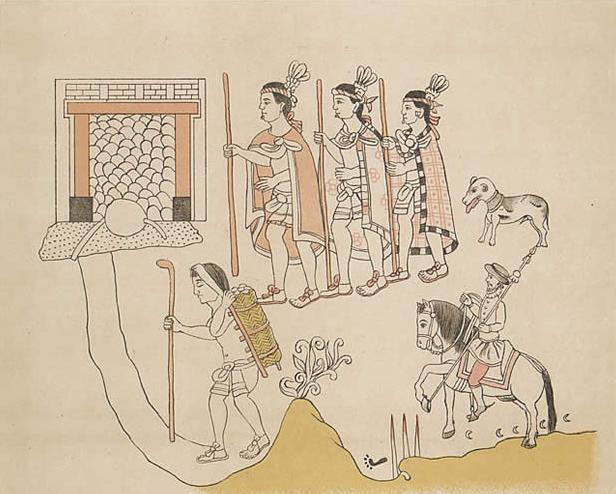 Depiction of a Spaniard entering Chalco with three Tlaxcalan soldiers and an Indigenous porter in the Lienzo de Tlaxcala (pre-1585) In 1492, the population of the Americas as a whole was about 50 to 100 million. By 1700, introduced diseases had reduced the native population by 90%.[66] European migration and transfer of slaves from Africa reduced the native population to a minority. By 1800 the population of North America comprised about 5 million Europeans and their descendants, one million Africans and 600,000 indigenous Americans.[67] Native populations also encountered new animals and plants introduced by Europeans. These included pigs, horses, mules, sheep and cattle; wheat, barley, rye, oats, grasses and grapevines. These exotic animals and plants radically transformed the local environment and disrupted traditional agriculture and hunting practices.[67] Oceania The indigenous populations of the Pacific had increasing contact with Europeans in the 18th century as British, French and Spanish expeditions explored the region. The natives of Tahiti had encounters with the expeditions of Wallis (1766), Bougainville (1768), Cook (1769) and many others before being formally colonized by the French in 1880.[68] The indigenous inhabitants of the Hawaiian Islands first encountered Europeans in 1778 when Cook explored the region.[69] Following increasing contact with European missionaries, traders and scientific expeditions, the indigenous population fell before their lands were annexed by the United States in 1893.[70] The Māori of New Zealand also had sporadic encounters with Europeans in the 17th and 18th centuries. Following encounters with Cook's exploration parties in 1769-70, New Zealand was visited by numerous European and North American whaling, sealing, and trading ships.[71] From the early 19th century, Christian missionaries began to settle New Zealand, eventually converting most of the Māori population.[72] The Māori population declined to around 40% of its pre-contact level during the 19th century; introduced diseases were the major factor.[73] New Zealand became a British Crown colony in 1841.[74][75] The Aboriginal inhabitants of Australia, after brief encounters with European explorers in the 17th and 18th centuries, had extensive contact with Europeans when the continent was progressively colonized by the British from 1788. During colonization, the Aboriginal people experienced depopulation from disease and settler violence, dispossession of their land, and severe disruption of their traditional cultures. By 1850, indigenous peoples were a minority in Australia.[76] European justifications for colonization See also: Discovery doctrine From the 15th to the 19th centuries, European powers used a number of rationales for the colonization of newly-encountered lands populated by indigenous peoples. These included a duty to spread the Gospel to non-Christians, to bring civilization to barbarian peoples, a natural law right to explore and trade freely with other peoples, and a right to settle and cultivate uninhabited or uncultivated land which they considered terra nullius ("no one's land").[77] Robert J. Miller, Jacinta Ruru, Larissa Behrendt and Tracey Lindberg argue that European powers rationalized their colonization of the New World by the discovery doctrine, which they trace back to papal decrees authorizing Spain and Portugal to conquer newly discovered non-Christian lands and convert their populations to Christianity.[78] Kent McNeil, however, states, "While Spain and Portugal favoured discovery and papal grants because it was generally in their interests to do so, France and Britain relied more on symbolic acts, colonial charters, and occupation."[79] Benton and Strauman argue that European powers often adopted multiple, sometimes contradictory, legal rationales for their acquisition of territory as a deliberate strategy in defending their claims against European rivals.[80] Settler independence and continuing colonialism See also: Settler colonialism Although the establishment of colonies throughout the world by various European powers aimed to expand those powers' wealth and influence, settler populations in some localities became anxious to assert their own autonomy. For example, settler independence movements in thirteen of the British American colonies were successful by 1783, following the American Revolutionary War. This resulted in the establishment of the United States of America as an entity separate from the British Empire. The United States continued and expanded European colonial doctrine through adopting a version of the discovery doctrine as law in 1823 with the US Supreme Court case Johnson v. McIntosh. Statements at the Johnson court case illuminated the United States' support for the principles of the discovery doctrine:[81] The United States ... [and] its civilized inhabitants now hold this country. They hold, and assert in themselves, the title by which it was acquired. They maintain, as all others have maintained, that discovery gave an exclusive right to extinguish the Indian title of occupancy, either by purchase or by conquest; and gave also a right to such a degree of sovereignty, as the circumstances of the people would allow them to exercise. ... [This loss of native property and sovereignty rights was justified, the Court said, by] the character and religion of its inhabitants ... the superior genius of Europe ... [and] ample compensation to the [Indians] by bestowing on them civilization and Christianity, in exchange for unlimited independence. Population and distribution  A map of uncontacted peoples, around the start of the 21st century Indigenous societies range from those who have been significantly exposed to the colonizing or expansionary activities of other societies (such as the Maya peoples of Mexico and Central America) through to those who as yet remain in comparative isolation from any external influence (such as the Sentinelese and Jarawa of the Andaman Islands). Precise estimates for the total population of the world's Indigenous peoples are very difficult to compile, given the difficulties in identification and the variances and inadequacies of available census data. The United Nations estimates that there are over 370 million Indigenous people living in over 70 countries worldwide.[82] This would equate to just fewer than 6% of the total world population. This includes at least 5,000 distinct peoples[83] in over 72 countries. Contemporary distinct Indigenous groups survive in populations ranging from only a few dozen to hundreds of thousands and more. Many Indigenous populations have undergone a dramatic decline and even extinction, and remain threatened in many parts of the world. Some have also been assimilated by other populations or have undergone many other changes. In other cases, Indigenous populations are undergoing a recovery or expansion in numbers. Certain Indigenous societies survive even though they may no longer inhabit their "traditional" lands, owing to migration, relocation, forced resettlement or having been supplanted by other cultural groups. In many other respects, the transformation of culture of Indigenous groups is ongoing, and includes permanent loss of language, loss of lands, encroachment on traditional territories, and disruption in traditional ways of life due to contamination and pollution of waters and lands. Environmental and economic benefits of the Indigenous stewardship of land This article may be unbalanced towards certain viewpoints. Please improve the article by adding information on neglected viewpoints, or discuss the issue on the talk page. (January 2022) See also: Climate change and indigenous peoples A WRI report mentions that "tenure-secure" Indigenous lands generates billions and sometimes trillions of dollars' worth of benefits in the form of carbon sequestration, reduced pollution, clean water and more. It says that tenure-secure Indigenous lands have low deforestation rates,[84][85] they help to reduce GHG emissions, control erosion and flooding by anchoring soil, and provide a suite of other local, regional and global ecosystem services. However, many of these communities find themselves on the front lines of the deforestation crisis, and their lives and livelihoods threatened.[86][87][88] Indigenous peoples and the environment Misconceptions about the historical relationship between Indigenous populations and their landbase has informed some Westerners view of California's "wild Eden", which may influence policy decisions about the "wilderness". Some academics assumed that the only pre-Colonial human interactions with nature were as "hunter-gatherers". Others say that the relationship was one of "calculated tempered use of nature as active agents of environmental change and stewardship". They argue that a view of "wilderness" as uninhabited nature has resulted in removal of Indigenous inhabitants to preserve "the wild", and that depriving the land of traditional Indigenous practices such as controlled burns, harvesting, and seed scattering has yielded dense understory shrubbery or tickets of young trees which are inhospitable to life. Recent studies indicate that Indigenous peoples used land sustainably, without causing substantial losses of biodiversity, for thousands of years.[89] A goal is to ascertain an unbiased view of Indigenous practices of resource management.[90][91][92][93] Historical literature, archaeological findings, ecological field studies, and Native Peoples' cultures show indications that Indigenous land management practices were largely successful in promoting habitat heterogeneity, increasing biodiversity, and maintaining certain vegetation types, sustaining human lives while conserving natural resources.[94] Recently, it has come to light that the deforestation rate of Indonesian rainforests has been far greater than estimated. Such a rate could not have been the product of globalization as understood before; rather, it seemed that ordinary local people dependent on these forests for their livelihoods are in fact "joining distant corporations in creating uninhabitable landscapes."[95] In eastern Penan, three categories of misrepresentation are noticeable: The Molong concept is purely a stewardship notion of resource management. Communities or individuals take ownership of specific trees, maintaining and harvesting from them sustainably over a long period of time. Some feel this practice has been romanticized in environmentalist writings. Landscape features and particularly their names in local languages provided geographical and historical information for Penan people; whereas in environmentalist accounts, it has turned into a spiritual practice where trees and rivers represent forest spirits that are sacred to the Penan people. A typical stereotype of some environmentalists' approach to ecological ethnography is to present Indigenous "knowledge" of nature as "valuable" to the outside world because of its hidden medicinal benefits. In reality, eastern Penan populations do not identify a medicinal stream of "knowledge". These misrepresentations in the "narrative" of Indigeneity and "value" of Indigenous knowledge might have been helpful for Penan's people in their struggle to protect their environment, but it might also have disastrous consequences. What happens if another case did not fit in this romantic narrative, or another Indigenous knowledge did not seem beneficial to the outside world. These people were being uprooted in the first place because their communities did not fit well with the state's system of values.[96] |
歴史 古典古代 古典期のギリシアの文献は、彼らが「ペラスギ人」と呼ぶ先住民を認めている。古代の著述家たちはこれらの人々をギリシア人の祖先[35]、あるいはギリシ ア人以前にギリシアに居住していた集団と見なしていた[36]。この前者の集団の性質と正確な身元はつかみどころがなく、ホメロス、ヘシオドス、ヘロドト スなどの資料はさまざまな、部分的には神話的な説明をしている。ハリカルナッソスのディオニシウスは、その著書『ローマ古代史』の中で、当時入手可能だっ た資料に基づき、ペラスギウス人はギリシア人であったと結論づけ、ペラスギウス人についての包括的な解釈を与えている[37]。 グレコ・ローマ社会は紀元前330年から紀元後640年の間に繁栄し、当時の既知の世界の半分以上を包摂する征服作戦を次々と行った。しかし、古典古代当 時、ヨーロッパの他の地域には、グレコ・ローマ世界と文化的に言ってより多くの共通点があったため、ヨーロッパの辺境を越えて拡大することに伴う複雑な問 題は、先住民の問題と比較してそれほど争うものではなかった[38][無関係な引用]。古代における中東では、多くの国家が興亡し、現代に痕跡を残さな かった。しかし、イスラエルの地に土着していたユダヤ人や、現在もサマリアという地名が残る地域に住む小さなサマリア人社会など、古代から衰えることなく 続いている文明も少なくない。 アフリカ 古代ヨーロッパ末期、北アフリカのベルベル人、コプト人、ヌビア人の多くがローマ帝国の支配下で様々なキリスト教に改宗したが、伝統的な宗教的信仰の要素 は保持されていた[39]。7世紀にアラブが北アフリカに侵攻した後、多くのベルベル人が奴隷にされたり、軍隊に徴用されたりした。しかしベルベル人の大 部分は遊牧民としてサハラ以南のアフリカまで交易に従事した。しかし10世紀になると、北アフリカの人口の大半がアラビア語を話し、イスラム教を信仰する ようになった[41]。  アロンソ・フェルナンデス・デ・ルゴが、捕虜となったテネリフェのグアンチェ王をフェルディナンドとイザベラに贈呈。 1402年以降、カナリア諸島のグアンチェ族はスペインによる植民地化の試みに抵抗した。1496年、ついにカナリア諸島はスペインの支配下に入った。モ ハメド・アディカリは島々の征服をジェノサイドと呼んだ[42][43]。 15世紀初頭のポルトガルのアフリカ西海岸探検の動機は、金の探求とイスラムに対する十字軍だった[44]。ポルトガルの現在のセネガルにおける最初の植 民地化の試みは失敗に終わった[45]。1488年、ポルトガル船は喜望峰を通過し[47]、17世紀までにポルトガルは西アフリカからインド、中国南部 までの海底交易路と要塞化された沿岸交易基地を築き、ブラジルに入植植民地を築いた[48]。 1532年、最初のアフリカ人奴隷がアメリカ大陸に直接輸送された。奴隷貿易はフランス、オランダ、イギリスの関与によって17世紀に急拡大し、19世紀 には衰退した。少なくとも1200万人の奴隷がアフリカから輸送された[49]。奴隷貿易は部族間の戦争を増加させ、西アフリカ内陸部の人口増加と経済発 展を阻害した[50][51]。 アメリカ大陸 関連項目 大航海時代 大航海時代には、先住民族とヨーロッパ人との遭遇が増加した。ヨーロッパ人の動機は、交易、[42][52]天然資源の開発、[42][53]キリスト教 の普及、[54]戦略的な軍事基地、植民地、入植地の確立など、さまざまな要因によるものであった[55]。 1492年以降、カリブ海諸島のアラワク族はクリストファー・コロンブスに率いられたスペインの植民者と遭遇した。スペイン人は先住民の一部を奴隷にし、 他の人々をエコミエンダと呼ばれる労働システムで農場や金鉱で働かせた。スペイン人の入植地はイスパニョーラからプエルトリコ、バハマ、キューバへと広が り、病気、栄養失調、入植者の暴力、文化の混乱によって先住民の人口が激減した[56][57]。 1520年代、メソアメリカの人々は金やその他の資源を求めて彼らの土地に侵入したスペイン人と遭遇した。先住民の中にはアステカの支配を終わらせるため にスペインと同盟を結ぶことを選んだ者もいた。スペインの侵入はメキシコ征服とアステカ帝国の終焉につながった。センポアラン人、トラスカラ人、その他の スペイン人の同盟者はある程度の自治権を与えられたが、スペイン人はメキシコの事実上の支配者だった。天然痘は先住民を荒廃させ、スペインの征服を助長し た[58]。  大航海時代(15世紀に始まる)の主な旅程を記した地図 1530年、スペインはパナマから南下し、南アメリカ西部のインカ帝国の土地に向かった。天然痘の流行と内戦で弱体化したインカは、1532年にカハマル カでスペイン軍に敗れ、皇帝アタハルパは捕らえられ処刑された。スペインは傀儡の皇帝を任命し、多くの先住民の支持を得てインカの首都クスコを占領した。 スペインは1535年に新たな首都を築き、1537年にはインカの反乱を打ち破り、ペルーの征服を強固なものにした[59]。 1560年代、スペインはフロリダに植民地を設立し、1598年にはニューメキシコに植民地を設立した[60]。しかし、スペイン植民地の中心地は依然と してニュースペイン(メキシコと中央アメリカの大部分を含む)とペルー(南アメリカの大部分を含む)であった[61]。 17世紀には、捕鯨、漁業、毛皮貿易を利用するために、フランス、イギリス、オランダの商館がアメリカ北部に増加した。フランス人の入植地はセント・ロー レンス川を五大湖まで、ミシシッピ川をルイジアナまで遡った[62]。イギリス人とオランダ人の入植地は現在のマサチューセッツからジョージアまで大西洋 岸に広がっていった[63]。先住民はまた、植民者との暴力的な対立や伝統的な土地の漸進的な収奪による損失を経験した[65]。  Lienzo de Tlaxcala』(1585年以前)に描かれた、3人のトラスカラ人兵士と先住民のポーターとともにチャルコに入るスペイン人の描写。 1492年、アメリカ大陸全体の人口は約5000万人から1億人であった。1700年までには、伝染病によって先住民の人口は90%減少した[66]。 1800年までに北アメリカの人口は、約500万人のヨーロッパ人とその子孫、100万人のアフリカ人、60万人のアメリカ先住民で構成されていた [67]。 先住民はヨーロッパ人によって持ち込まれた新しい動物や植物にも遭遇した。ブタ、ウマ、ラバ、ヒツジ、ウシ、小麦、大麦、ライ麦、オート麦、牧草、ブドウ の木などである。これらの外来の動物や植物は、地域の環境を根本的に変え、伝統的な農業や狩猟の慣習を崩壊させた[67]。 オセアニア 太平洋の先住民は、18世紀にイギリス、フランス、スペインの探検隊がこの地域を探検するにつれて、ヨーロッパ人との接触が増えていった。タヒチの原住民 は1880年にフランスによって正式に植民地化されるまで、ウォリス(1766年)、ブーゲンビル(1768年)、クック(1769年)などの探検隊と遭 遇している[68]。 ニュージーランドのマオリ族も17世紀から18世紀にかけてヨーロッパ人と散発的に遭遇した。1769年から70年にかけてクックの探検隊と遭遇した後、 ニュージーランドには多くのヨーロッパや北アメリカの捕鯨船、密漁船、貿易船が訪れた[71]。 19世紀初頭から、キリスト教の宣教師がニュージーランドに定住し始め、最終的にマオリの人口のほとんどを改宗させた[72]。 マオリの人口は、19世紀には接触前の40%程度まで減少した。 オーストラリアの原住民アボリジニは、17世紀と18世紀にヨーロッパの探検家と短期間遭遇した後、1788年からイギリスによってオーストラリア大陸が 徐々に植民地化されると、ヨーロッパ人と広範囲に接触するようになった。植民地化の間、アボリジニの人々は病気や入植者の暴力による過疎化、土地の剥奪、 伝統文化の深刻な破壊を経験した。1850年までに、先住民はオーストラリアでは少数派となった[76]。 ヨーロッパ人による植民地化の正当化 参照 大航海時代 15世紀から19世紀にかけて、ヨーロッパ列強は先住民族が居住する新たな土地を植民地化するために多くの根拠を用いた。その中には、非キリスト教徒に福 音を広める義務、野蛮な民族に文明をもたらす義務、他の民族と自由に探検し交易する自然法の権利、テラ・ヌリウス(「誰の土地でもない」)と考えられてい た無人の土地や耕作されていない土地に定住し耕作する権利などが含まれていた[77]。 ロバート・J・ミラー、ジャシンタ・ルル、ラリッサ・ベーレント、トレーシー・リンドバーグは、ヨーロッパ列強が発見の教義によって新大陸の植民地化を合 理化したと論じており、その教義はスペインとポルトガルに新たに発見された非キリスト教の土地を征服し、その住民をキリスト教に改宗させることを許可した ローマ教皇の勅令にまで遡る。 [しかしケント・マクニール(Kent McNeil)は、「スペインとポルトガルが発見と教皇の勅許を支持したのは、そうすることが一般的に自分たちの利益になったからであるのに対して、フラ ンスとイギリスは象徴的行為、植民地憲章、占領により依存していた」と述べている[79]。ベントンとストラウマン(Benton and Strauman)は、ヨーロッパの列強は、ヨーロッパのライバルから自分たちの主張を守るための意図的な戦略として、領土の獲得に複数の、時には矛盾す る法的根拠をしばしば採用したと論じている[80]。 入植者の独立と植民地主義の継続 以下も参照: 入植者植民地主義 様々なヨーロッパ列強による世界各地への植民地設立は、それらの列強の富と影響力の拡大を目指したものであったが、一部の地域の入植者たちは、自らの自治 権を主張することに不安を抱くようになった。たとえば、イギリス領アメリカの13植民地では、アメリカ独立戦争後の1783年までに入植者の独立運動が成 功した。その結果、大英帝国から独立した組織としてアメリカ合衆国が設立された。アメリカ合衆国は、1823年、ジョンソン対マッキントッシュの連邦最高 裁判決により、ディスカバリー・ドクトリンを法律として採用し、ヨーロッパの植民地主義を継続・拡大した。ジョンソン裁判での発言は、ディスカバリー・ド クトリンの原則に対する米国の支持を示すものであった[81]。 合衆国は [合衆国...およびその文明化された住民は、現在この国を保有している。合衆国は......(そして)その文明化された住民とともに、現在この国を保 有しており、この国が獲得された権原を自らのものとして主張している。彼らは、他のすべての者が主張してきたように、発見が、購入または征服によってイン ディアンの占有権を消滅させる排他的な権利を与えたと主張し、また、人々の状況によって行使できる程度の主権に対する権利も与えたと主張する。[この先住 民の財産権と主権権の喪失は、住民の性格と宗教、ヨーロッパの優れた才能によって正当化される。[無制限の独立と引き換えに、文明とキリスト教を与えるこ とによって、[インディアン]に十分な補償がなされた。 人口と分布  21世紀初頭頃の未接触民族の地図 先住民社会には、他の社会による植民地化または拡大活動に大きくさらされてきた社会(メキシコや中央アメリカのマヤ族など)から、まだ外部からの影響を受 けずに比較的隔離された状態にある社会(アンダマン諸島のセンチネル人やジャラワ人など)まで、さまざまなものがある。 世界の先住民の総人口を正確に推定することは、識別の難しさや、入手可能な国勢調査データのばらつきや不十分さを考えると、非常に困難である。国連は、世 界70カ国以上に3億7,000万人以上の先住民が暮らしていると推定している[82]。この中には、72カ国以上の少なくとも5,000の異なる民族 [83]が含まれている。 現代の明確な先住民集団は、わずか数十人から数十万人以上の集団で存続している。多くの先住民集団は激減し、絶滅さえも経験しており、世界の多くの地域で 絶滅の危機に瀕している。また、他の集団に同化されたり、多くの変化を遂げたものもある。また、先住民の数が回復または拡大している場合もある。 ある種の先住民社会は、移住や移動、強制的な定住、あるいは他の文化集団に取って代わられたことによって、もはや「伝統的な」土地に住んでいないにもかか わらず存続している。その他多くの点で、先住民族の文化の変容は進行中であり、言語の永続的な喪失、土地の喪失、伝統的領土への侵入、水や土地の汚染や汚 染による伝統的生活様式の崩壊などがある。 先住民の土地管理による環境的・経済的利益 この記事は特定の視点に偏っている可能性があります。無視されている視点に関する情報を追加して記事を改善するか、トークページでこの問題について議論し てください。(2022年1月) こちらもご覧ください: 気候変動と先住民族 WRIの報告書では、「所有権を確保した」先住民の土地は、炭素隔離、汚染削減、きれいな水などの形で、数十億ドル、時には数兆ドル相当の利益を生み出す と言及している。同報告書によれば、土地所有権の確保された先住民の土地は、森林減少率が低く[84][85]、温室効果ガスの排出を削減し、土壌を固定 することで浸食や洪水を抑制し、その他の一連の地域的、地域的、世界的な生態系サービスを提供している。しかし、これらのコミュニティの多くは、森林減少 の危機の最前線に立たされ、彼らの生活と生計が脅かされていることに気づいている[86][87][88]。 先住民族と環境 先住民族とその土地基盤との歴史的関係に関する誤解は、カリフォルニアの「野生のエデン」に対する一部の西洋人の見方に影響を与え、それが「原生地域」に 関する政策決定に影響を与えている可能性がある。ある学者は、植民地時代以前の人類と自然との関わりは「狩猟採集民」だけであったと仮定した。また、「環 境変化とスチュワードシップの積極的な担い手として、計算された節度ある自然の利用」という関係であったという学者もいる。彼らは、「原生地域」を人の住 まない自然としてとらえることで、「野生」を守るために先住民を排除し、管理された焼畑、伐採、種子散布といった先住民の伝統的な慣習を土地から奪うこと で、生物を寄せ付けない鬱蒼とした下層の低木や若木の茂みを生み出してきたと主張する。最近の研究によると、先住民は何千年もの間、生物多様性の実質的な 損失を引き起こすことなく、土地を持続可能な形で利用してきたことが示されている[89]。 歴史的文献、考古学的知見、生態学的フィールド調査、先住民の文化は、先住民の土地管理の実践が、生息地の不均質性を促進し、生物多様性を増加させ、特定 の植生タイプを維持し、天然資源を保全しながら人間の生活を維持することに概ね成功していたことを示している[94]。 近年、インドネシアの熱帯雨林の伐採率が推定をはるかに上回っていることが明らかになった。このような速度は、以前から理解されていたようなグローバリ ゼーションの産物ではなく、むしろ、これらの森林に生計を依存している地元の普通の人々が、実際には「居住不可能な景観を作り出すために、遠く離れた企業 に加担している」ように思われた[95]。 東部ペナンでは、3つの誤った表現が目立つ: モロンの概念は、純粋に資源管理のスチュワードシップの概念である。コミュニティや個人が特定の樹木を所有し、長期にわたって持続可能な形で維持し、収穫 する。この慣習は、環境保護主義者の著作ではロマンチックに扱われていると感じる人もいる。しかし、環境保護主義者の記述では、この慣習はペナン族にとっ て神聖な森の精霊である木々や川を象徴する精神的な慣習に変わってしまっている。一部の環境保護主義者の生態学的民族誌に対するアプローチの典型的なステ レオタイプは、先住民の自然に対する「知識」を、その隠された薬効によって外部世界に対して「価値あるもの」として提示することである。現実には、東部ペ ナン族は「知識」の薬効的な流れを認識していない。先住民の「物語」と先住民の「知識」の「価値」におけるこうした誤った表現は、ペナンの人々が環境を守 ろうと奮闘する際に役立ったかもしれないが、同時に悲惨な結果をもたらすかもしれない。別の事例がこのロマンティックな物語に当てはまらなかったり、別の 先住民の知識が外の世界にとって有益に思えなかったりしたらどうなるか。そもそもこうした人々が根こそぎにされたのは、彼らのコミュニティが国家の価値体 系にうまく適合しなかったからである[96]。 |
| Indigenous peoples by region See also: List of Indigenous peoples Indigenous populations are distributed in regions throughout the globe. The numbers, condition and experience of Indigenous groups may vary widely within a given region. A comprehensive survey is further complicated by sometimes contentious membership and identification. Africa Main article: Indigenous peoples of Africa See also: Category:Indigenous peoples of Africa Sub-Saharan Africa 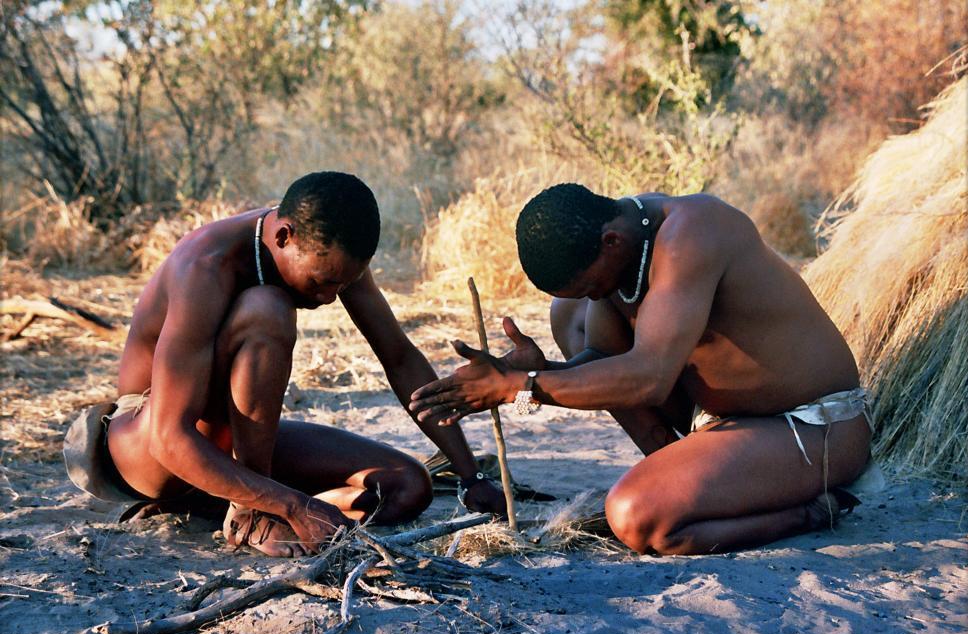 Starting fire by hand, San people in Botswana. 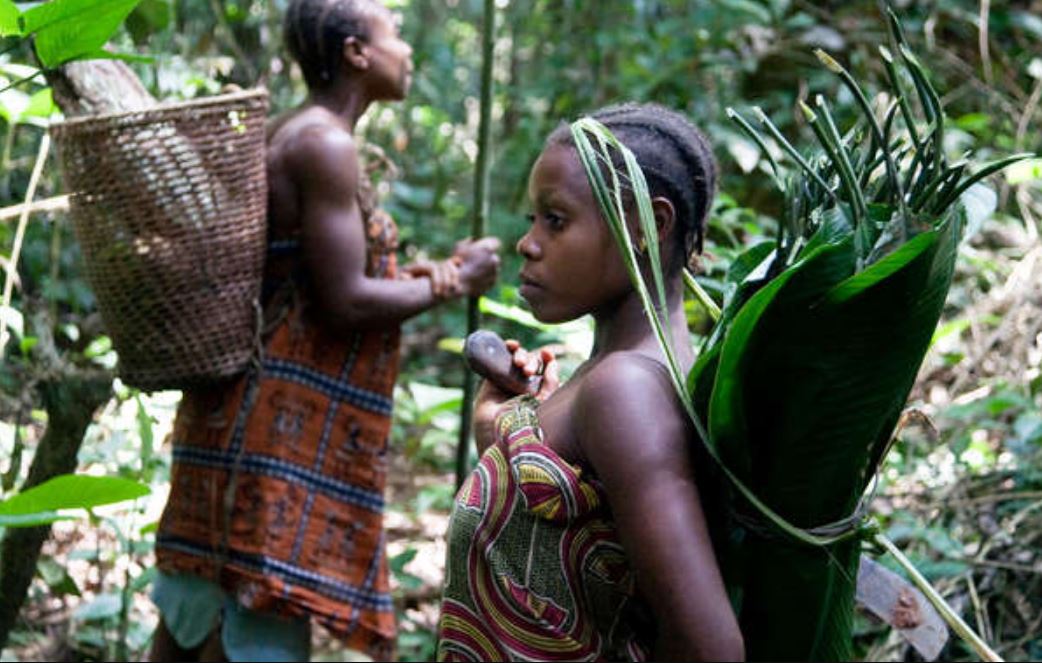 African Pygmies in Congo In the postcolonial period, the concept of specific Indigenous peoples within the African continent has gained wider acceptance, although not without controversy. The highly diverse and numerous ethnic groups that comprise most modern, independent African states contain within them various peoples whose situation, cultures and pastoralist or hunter-gatherer lifestyles are generally marginalized and set apart from the dominant political and economic structures of the nation. Since the late 20th century these peoples have increasingly sought recognition of their rights as distinct Indigenous peoples, in both national and international contexts. Though the vast majority of African peoples are "indigenous" in the sense that they originate from that continent, in practice, identity as an Indigenous people per the modern definition is more restrictive, and certainly not every African ethnic group claims identification under these terms. Groups and communities who do claim this recognition are those who, by a variety of historical and environmental circumstances, have been placed outside of the dominant state systems, and whose traditional practices and land claims often come into conflict with the objectives and policies implemented by governments, companies and surrounding dominant societies. North Africa The indigenous peoples of North Africa predominantly comprise the Berbers in the Maghreb and the Copts and Nubians in the Nile Valley. The vast majority of them have been Arabized after the Islamic conquests under the Rashidun and Umayyad caliphates. Americas Main article: Indigenous peoples of the Americas See also: Category:Indigenous peoples of the Americas 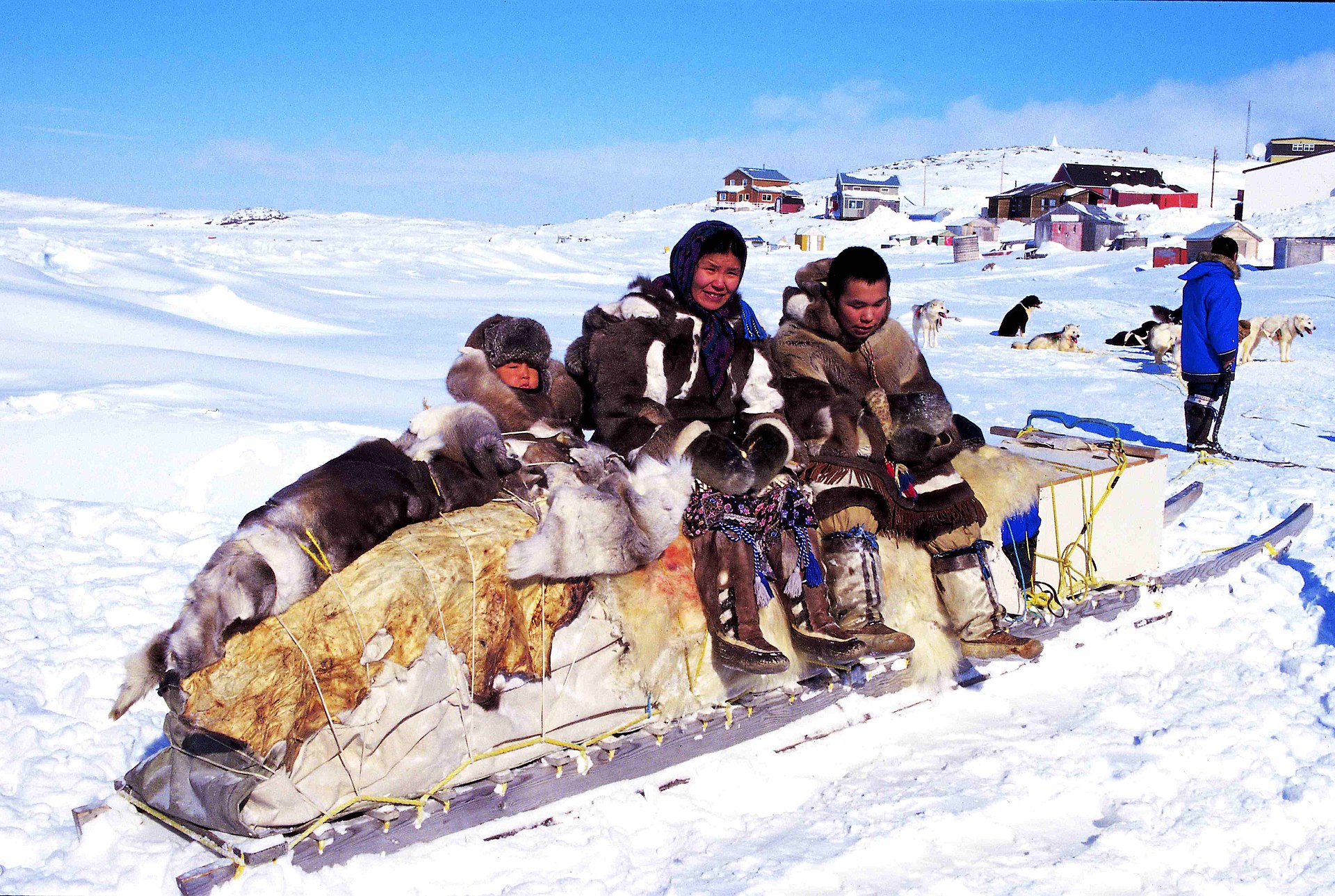 Inuit on a traditional qamutik (dog sled) in Cape Dorset, Nunavut, Canada. 1999. 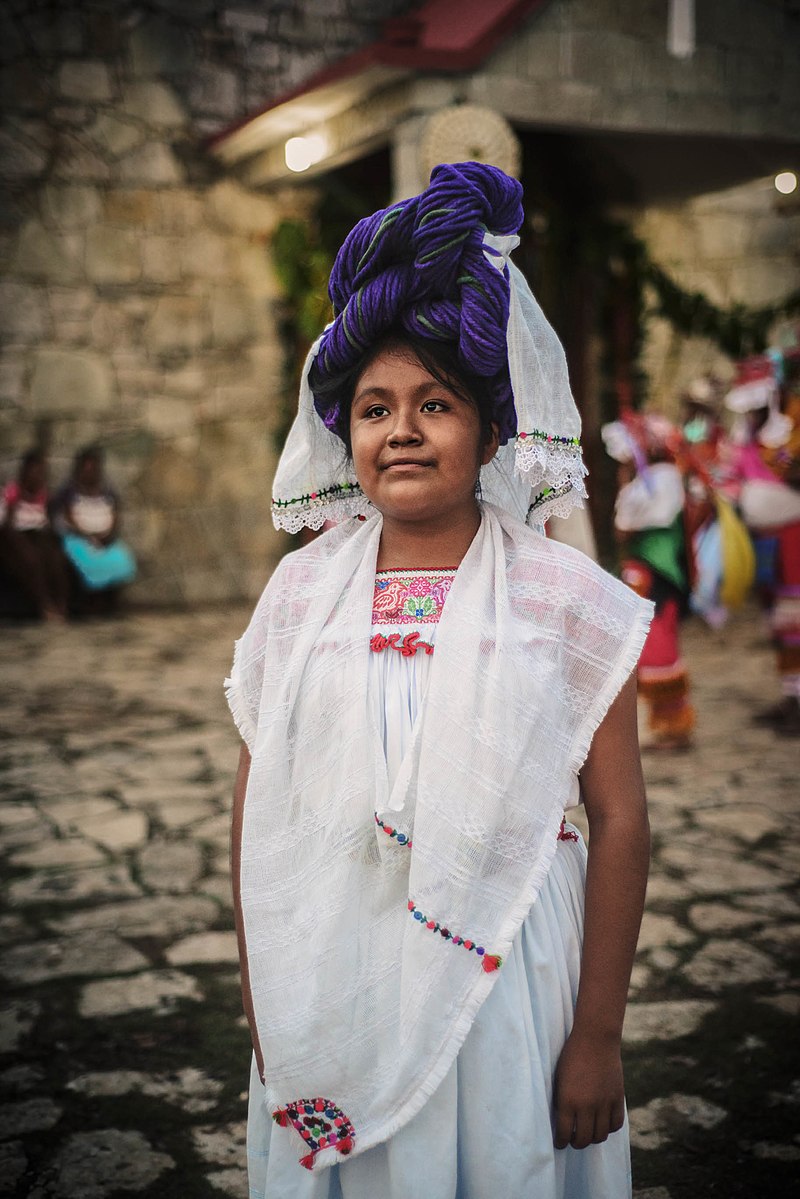 A girl wears the traditional Nahua headdress in Yohualichan, Veracruz. Indigenous peoples of the Americas are broadly recognized as being those groups and their descendants who inhabited the region before the arrival of European colonizers and settlers (i.e., pre-Columbian). Indigenous peoples who maintain, or seek to maintain, traditional ways of life are found from the high Arctic north to the southern extremities of Tierra del Fuego. The impacts of historical and ongoing European colonization of the Americas on Indigenous communities have been in general quite severe, with many authorities estimating ranges of significant population decline primarily due to disease, land theft and violence. Several peoples have become extinct, or very nearly so. But there are and have been many thriving and resilient Indigenous nations and communities. North America North America is sometimes referred to by Indigenous peoples as Abya Yala or Turtle Island. In Mexico, about 11 million people, or 9% of Mexico's total population, self-reported as Indigenous in 2015, making it the country with the highest Indigenous population in North America.[97][98] In the southern states of Oaxaca (65.73%) and Yucatán (65.40%), the majority of the population is Indigenous, as reported in 2015. Other states with high populations of Indigenous peoples include Campeche (44.54%), Quintana Roo, (44.44%), Hidalgo, (36.21%), Chiapas (36.15%), Puebla (35.28%), and Guerrero (33.92%).[99][100] Indigenous peoples in Canada comprise the First Nations,[101] Inuit[102] and Métis.[103] The descriptors "Indian" and "Eskimo" have fallen into disuse in Canada.[104][105] More currently, the term "Aboriginal" is being replaced with "Indigenous". Several national organizations in Canada changed their names from "Aboriginal" to "Indigenous". Most notable was the change of Aboriginal Affairs and Northern Development Canada (AANDC) to Indigenous and Northern Affairs Canada (INAC) in 2015, which then split into Indigenous Services Canada and Crown-Indigenous Relations and Northern Development Canada in 2017.[106] According to the 2016 Census, there are around 1,670,000 Indigenous people in Canada.[107] There are currently over 600 recognized First Nations governments or bands spread across Canada, such as the Cree, Mohawk, Mikmaq, Blackfoot, Coast Salish, Innu, Dene and more, with distinctive Indigenous cultures, languages, art, and music.[108][109] First Nations peoples signed 11 numbered treaties[110] across much of what is now known as Canada between 1871 and 1921, except in parts of British Columbia. The Inuit have achieved a degree of administrative autonomy with the creation in 1999 of the territories of Nunavik (in Northern Quebec), Nunatsiavut (in Northern Labrador) and Nunavut, which was until 1999 a part of the Northwest Territories. The autonomous territory of Greenland within the Kingdom of Denmark is also home to a recognized Indigenous and majority population of Inuit (about 85%) who settled the area in the 13th century, displacing the Indigenous European Greenlandic Norse.[111][112][113][114] In the United States, the combined populations of Native Americans, Inuit and other Indigenous designations totaled 2,786,652 (constituting about 1.5% of 2003 U.S. census figures). Some 563 scheduled tribes are recognized at the federal level, and a number of others recognized at the state level. Central and South America 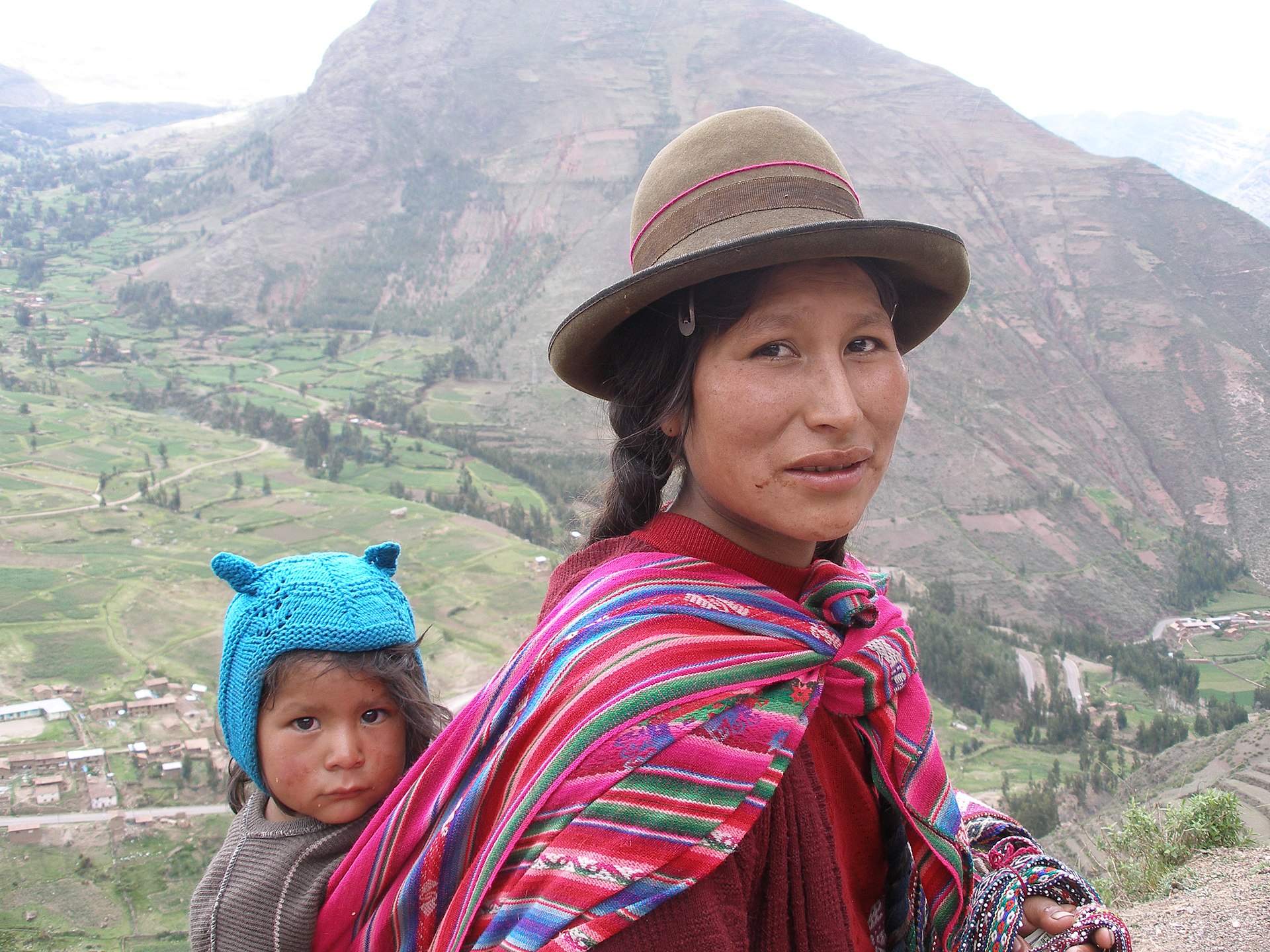 Quechua woman and child in the Sacred Valley, Andes, Peru In some countries (particularly in Latin America), Indigenous peoples form a sizable component of the overall national population – in Bolivia, they account for an estimated 56–70% of the total nation, and at least half of the population in Guatemala and the Andean and Amazonian nations of Peru. In English, Indigenous peoples are collectively referred to by different names that vary by region, age and ethnicity of speakers, with no one term being universally accepted. While still in use in-group, and in many names of organizations, "Indian" is less popular among younger people, who tend to prefer "Indigenous" or simply "Native, with most preferring to use the specific name of their tribe or Nation instead of generalities. In Spanish or Portuguese speaking countries, one finds the use of terms such as índios, pueblos indígenas, amerindios, povos nativos, povos indígenas, and, in Peru, Comunidades Nativas (Native Communities), particularly among Amazonian societies like the Urarina[115] and Matsés. In Chile, there the most populous indigenous peoples are the Mapuches in the Center-South and the Aymaras in the North.[116] Rapa Nui of Easter Island, who are a Polynesian people, are the only non-Amerindian indigenous people in Chile. Indigenous peoples make up 0.4% of all Brazilian population, or about 700,000 people.[117] Indigenous peoples are found in the entire territory of Brazil, although the majority of them live in Indian reservations in the North and Center-Western part of the country. On 18 January 2007, FUNAI reported that it had confirmed the presence of 67 different uncontacted peoples in Brazil, up from 40 in 2005. With this addition Brazil has now overtaken the island of New Guinea as the country having the largest number of uncontacted peoples.[118] Asia See also: Category:Indigenous peoples of Asia 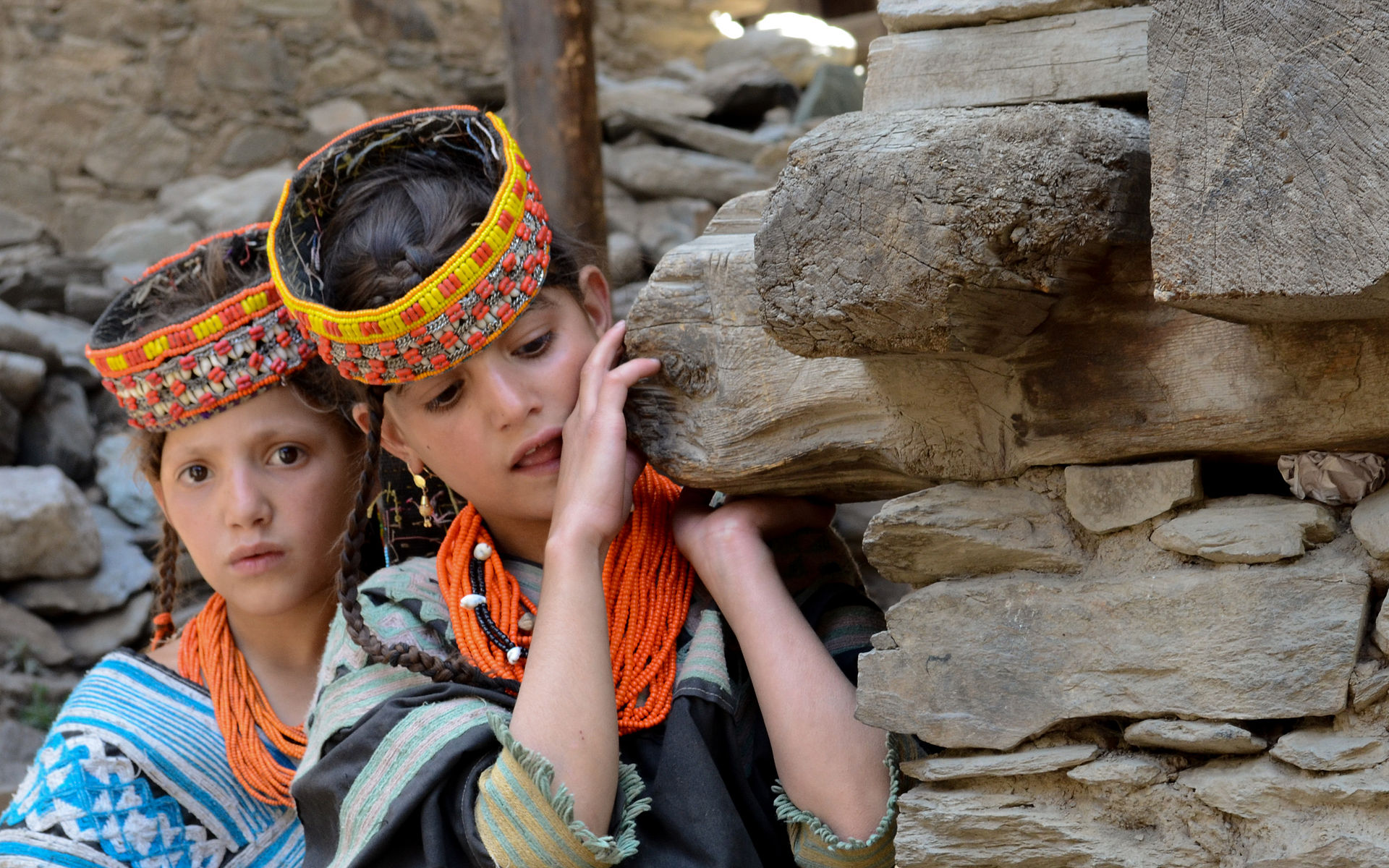 Kalash girls in Pakistan West Asia Armenians are the Indigenous people of the Armenian Highlands.[119][120][121][122] There are currently more Armenians living outside their ancestral homeland because of the Armenian genocide of 1915. Arabs are indigenous to the Arabian Peninsula, having spread to the greater middle East and North Africa following the Muslim Conquests in 7th and 8th centuries.[123][124][125] Anatolian Greeks, including the Pontic Greeks and Cappadocian Greeks, are the Greek-speaking minorities that existed in Anatolia millennia before Turkic conquest. They are indigenous to Asiatic Turkey.[119][126][127][128] Most were either killed in the Greek genocide or displaced during the following population exchange; however, some remain in Turkey.[129][130] There has been a Greek presence in Anatolia since at least the 1000s BCE,[131][132] and Greek traders visited western Anatolia beginning in 1900 BCE.[133] Assyrians are indigenous to Mesopotamia.[134][135][119][136] They claim descent from the ancient Neo-Assyrian Empire, and lived in what was Assyria, their original homeland, and still speak dialects of Aramaic, the official language of the Assyrian Empire. Copts are an ethnoreligious group, indigenous to Egypt and parts of the Sudan and Libya, one of the oldest Christian communities in the world.[137][138] Georgians are indigenous to Georgia. Kurds are one of the Indigenous peoples of Mesopotamia.[139][140][141][142][143] Yazidis are indigenous to Upper Mesopotamia.[144][119][145][146][147] There are competing claims that Palestinian Arabs and Jews are indigenous to historic Palestine/the Land of Israel (known as Erez Israel).[148][149][150] Zionism in the 19th and 20th century called for the restoration of Jews to their ancient homeland.[151][152][153] The argument entered the Israeli–Palestinian conflict in the 1990s, with Palestinians claiming Indigenous status as a pre-existing population displaced by Jewish settlement, and currently constituting a minority in the State of Israel.[154][155] Israeli Jews claim indigenous status by highlighting their historical and religious connections to the land, regarding it their ancestral homeland, and consider the establishment of modern Israel as a long-awaited return after centuries of dispersion and persecution.[156][157] Jews have had a continuous presence in the South Western Levant since biblical times, but, due to persecution and exile, Jews became a minority during the late Roman Empire.[158] [159][160][161][162] In 2007, the Negev Bedouin were officially recognized as an indigenous people of Israel by the United Nations.[163] This has been criticized both by scholars associated with the Israeli state, who dispute the Bedouin's claim to indigeneity,[164] and those who argue that recognizing just one group of Arab peoples as indigenous risks undermining others' claims and "fetishizing" nomadic cultures.[165] South Asia 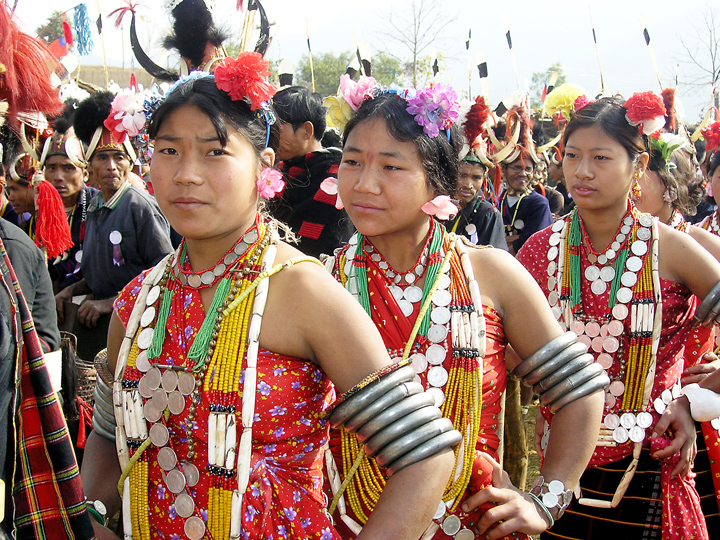 Naga people in Northeast India India's Andaman and Nicobar Islands in the Indian Ocean are also home to several Indigenous groups such as the Andamanese of Strait Island, the Jarawas of Middle Andaman and South Andaman Islands, the Onge of Little Andaman Island and the uncontacted Sentinelese of North Sentinel Island. They are registered and protected by the Indian government. In Sri Lanka, the Indigenous Vedda people constitute a small minority of the population today. 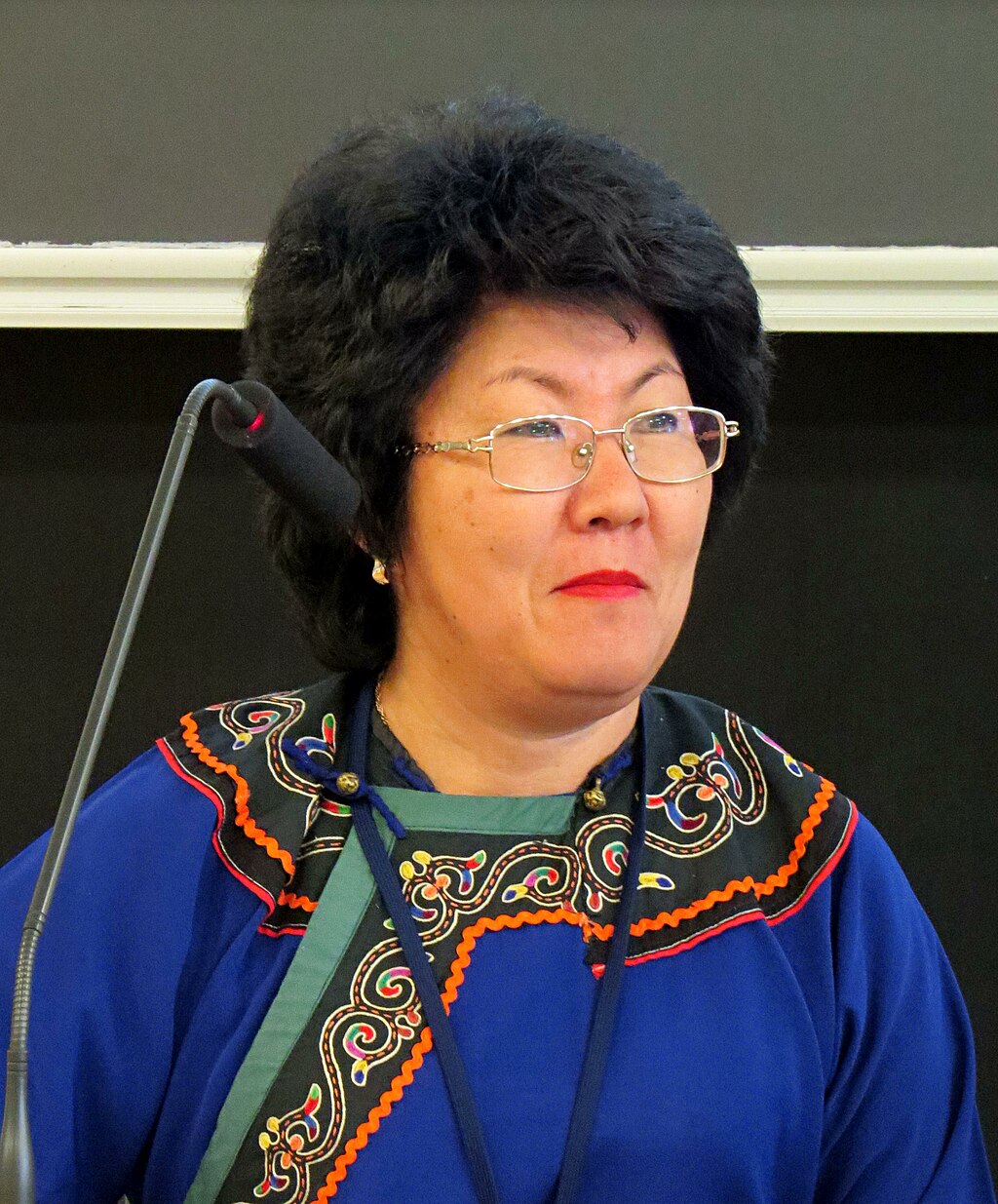 Marina A. Temina, a native speaker and teacher of the Nivkh language 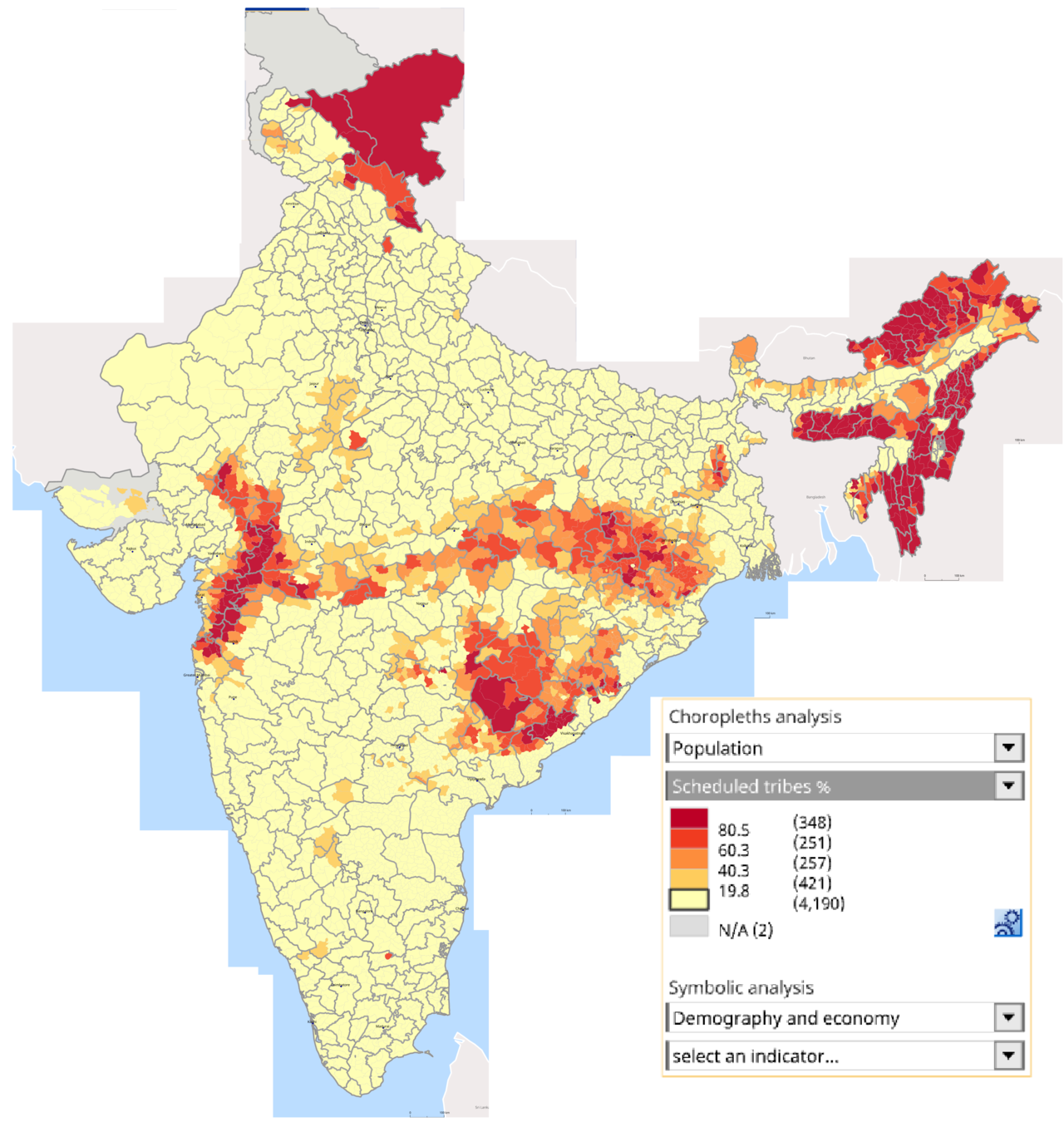 Percent of scheduled tribes in India by tehsils by census 2011 Northeast Asia 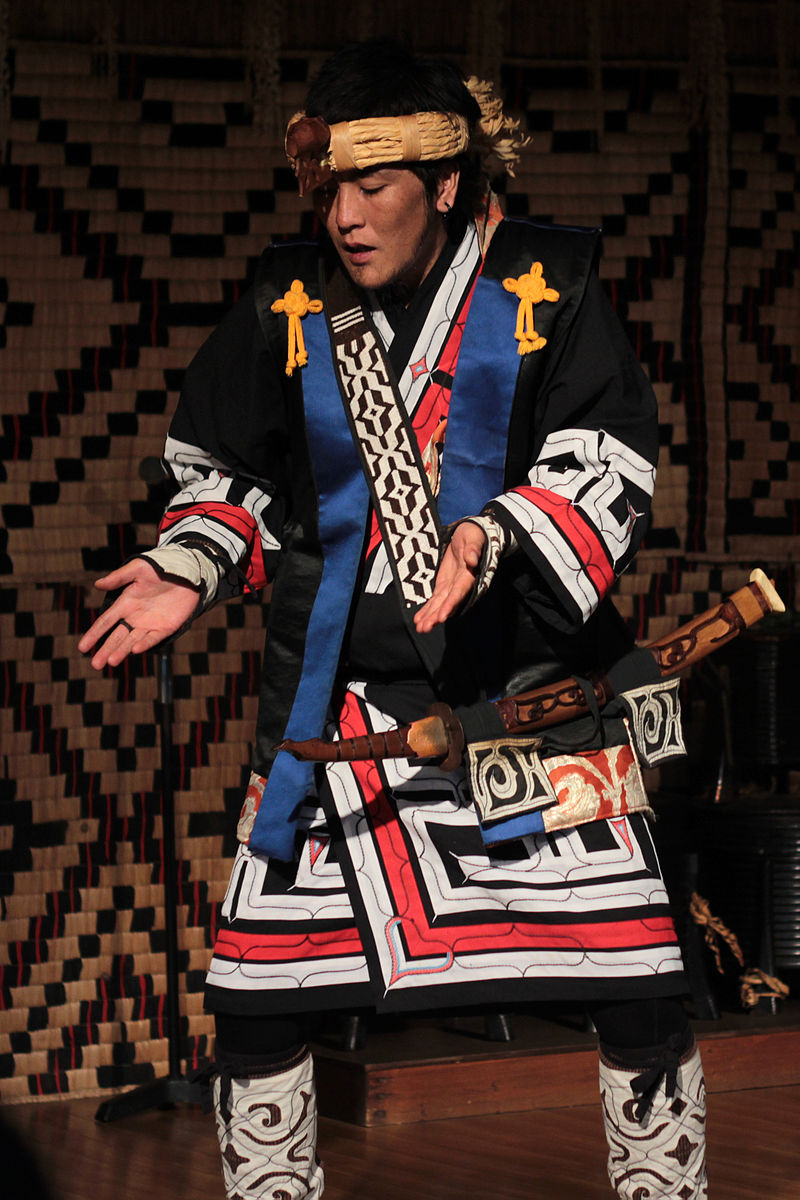 Ainu man performing a traditional Ainu dance Ainu people are an ethnic group indigenous to Hokkaidō, the Kuril Islands, and much of Sakhalin. As Japanese settlement expanded, the Ainu were pushed northward and fought against the Japanese in Shakushain's Revolt and Menashi-Kunashir Rebellion, until by the Meiji period they were confined by the government to a reservation near Lake Akan in Hokkaidō.[166] In a ground-breaking 1997 decision involving the Ainu people of Japan, the Japanese courts recognized their claim in law, stating that "If one minority group lived in an area prior to being ruled over by a majority group and preserved its distinct ethnic culture even after being ruled over by the majority group, while another came to live in an area ruled over by a majority after consenting to the majority rule, it must be recognized that it is only natural that the distinct ethnic culture of the former group requires greater consideration."[167] The Dzungar Oirats are indigenous to the Dzungaria in Northern Xinjiang. The Sarikoli Pamiris are indigenous to Tashkurgan in Xinjiang. The Tibetans are indigenous to Tibet. The Ryukyuan people are indigenous to the Ryukyu Islands. The Jeju people are indigenous to Jeju Island, South Korea. The languages of Taiwanese aborigines have significance in historical linguistics, since in all likelihood Taiwan was the place of origin of the entire Austronesian language family, which spread across Oceania.[168][169][170] In Hong Kong, the indigenous inhabitants of the New Territories are defined in the Sino-British Joint Declaration as people descended through the male line from a person who was in 1898, before Convention for the Extension of Hong Kong Territory.[171] There are several different groups that make up the indigenous inhabitants, the Punti, Hakka, Hoklo, and Tanka. All are nonetheless considered part of the Cantonese majority, although some like the Tanka have been shown to have genetic and anthropological roots in the Baiyue people, the pre-Han Chinese inhabitants of Southern China. The Russians invaded Siberia and conquered the indigenous people in the 17th–18th centuries. Nivkh people are an ethnic group indigenous to Sakhalin, having a few speakers of the Nivkh language, but their fisher culture has been endangered due to the development of oil field of Sakhalin from 1990s.[172] In Russia, definition of "Indigenous peoples" is contested largely referring to a number of population (less than 50,000 people), and neglecting self-identification, origin from indigenous populations who inhabited the country or region upon invasion, colonization or establishment of state frontiers, distinctive social, economic and cultural institutions.[6][173] Thus, indigenous peoples of Russia such as Sakha, Komi, Karelian and others are not considered as such due to the size of the population (more than 50,000 people), and consequently they "are not the subjects of the specific legal protections."[174] The Russian government recognizes only 40 ethnic groups as indigenous peoples, even though there are 30 other groups to be counted as such. The reason of nonrecognition is the size of the population and relatively late advent to their current regions, thus indigenous peoples in Russia should be numbered less than 50,000 people.[173][175][176] Southeast Asia 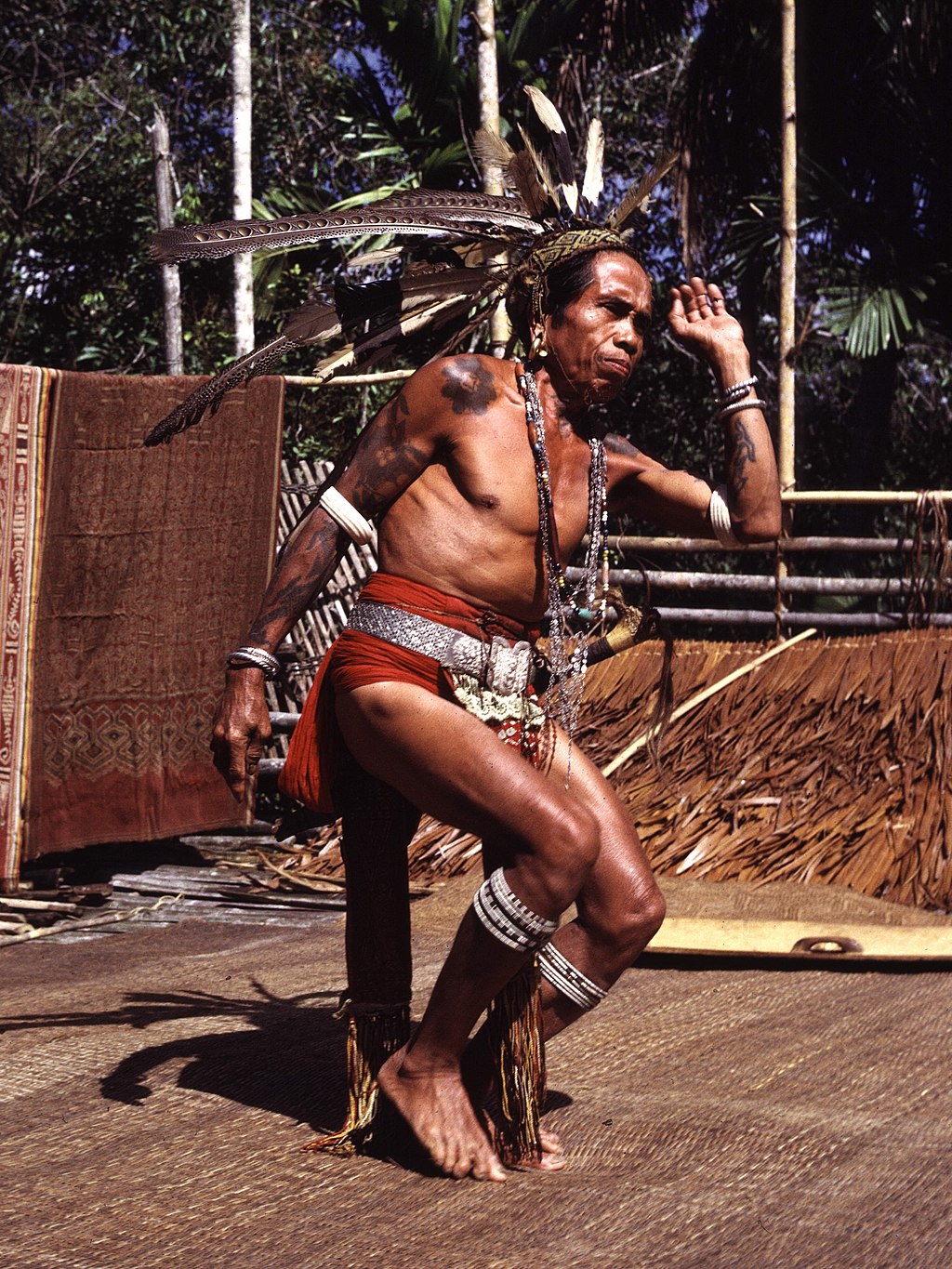 Dayak people in Borneo The Malay Singaporeans are the Indigenous people of Singapore, inhabiting it since the Austronesian migration. They had established the Kingdom of Singapura back in the 13th century. The name "Singapore" is an anglicisation of the Malay name Singapura which is derived from the Sanskrit word for 'lion city'. The native Malay name for the main island of Singapore is Pulau Ujong. Dayak People are one of the Indigenous groups of Borneo. It is a loose term for over 200 riverine and hill-dwelling ethnic groups, located in Borneo, each with its own dialect, customs, laws, territory, and culture, although common distinguishing traits are readily identifiable. The Cham are the Indigenous people of the former state of Champa which was conquered by Vietnam in the Cham–Vietnamese wars during Nam tiến. The Cham in Vietnam are only recognized as a minority, and not as an Indigenous people by the Vietnamese government despite being indigenous to the region. The Degar (Montagnards) are indigenous to Central Highlands (Vietnam) and were conquered by the Vietnamese in the Nam tiến. The Khmer Krom are the Indigenous people of the Mekong Delta and Saigon which were acquired by Vietnam from Cambodian King Chey Chettha II in exchange for a Vietnamese princess. In Indonesia, there are 50 to 70 million people who classify as indigenous peoples.[177] However, the Indonesian government does not recognize the existence of indigenous peoples, classifying every Native Indonesian ethnic group as "indigenous" despite the clear cultural distinctions of certain groups.[178] This problem is shared by many other countries in the ASEAN region. In the Philippines, there are 135 ethno-linguistic groups, majority of which are considered as Indigenous peoples by mainstream Indigenous ethnic groups in the country. The Indigenous people of Cordillera Administrative Region and Cagayan Valley in the Philippines are the Igorot people. The Indigenous peoples of Mindanao are the Lumad peoples and the Moro (Tausug, Maguindanao Maranao and others) who also live in the Sulu archipelago. There are also others sets of Indigenous peoples in Palawan, Mindoro, Visayas, and the rest central and south Luzon. The country has one of the largest Indigenous peoples population in the world. In Myanmar, indigenous peoples include the Shan, the Karen, the Rakhine, the Karenni, the Chin, the Kachin and the Mon. However, there are more ethnic groups that are considered indigenous, for example, the Akha, the Lisu, the Lahu or the Mru, among others.[179] Europe Main article: Ethnic groups in Europe See also: Genetic history of Europe and Category:Indigenous peoples of Europe 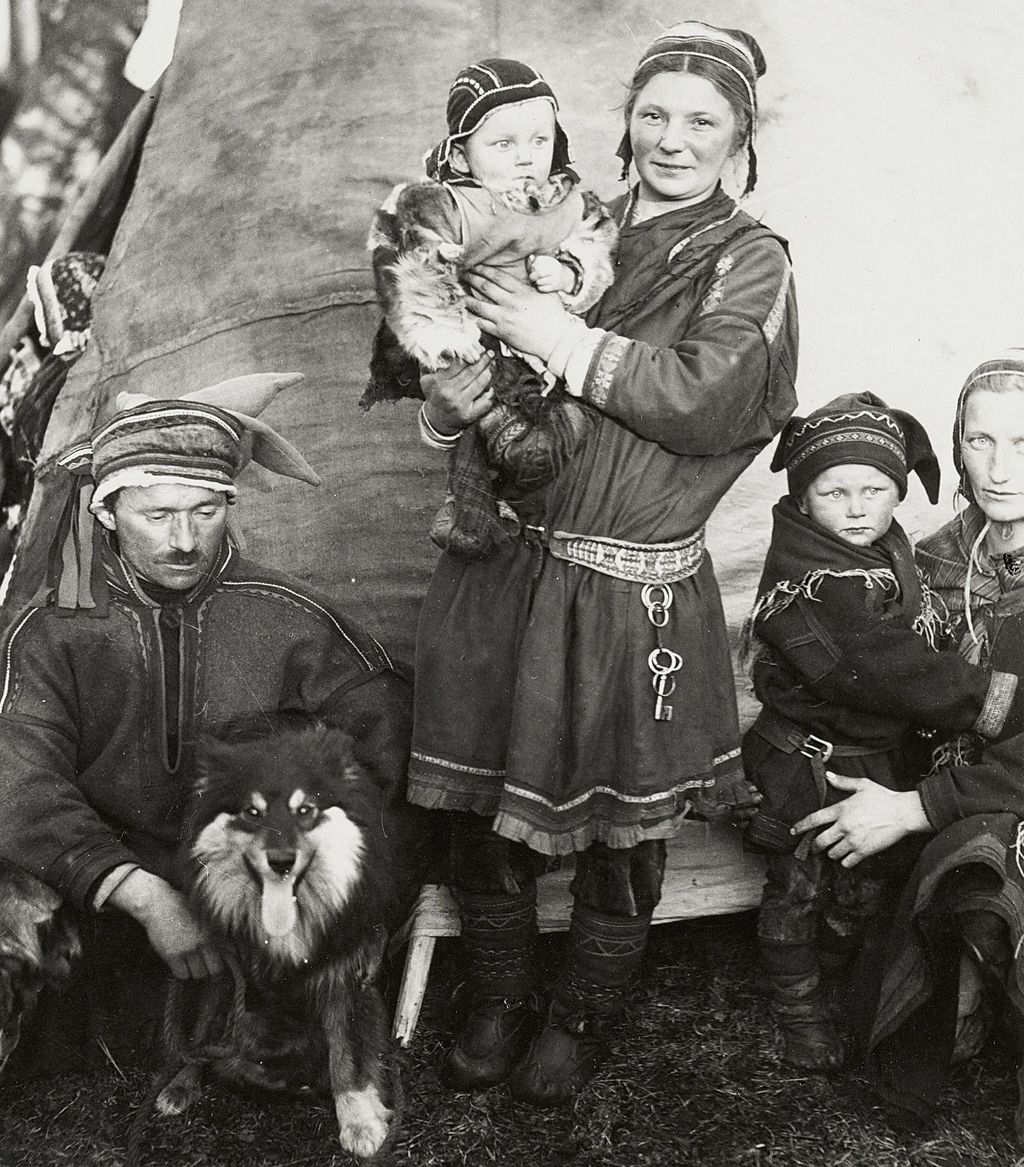 Sámi family in Lapland, 1936 Various ethnic groups have lived in Europe for millennia. However, the concept of indigenous peoples is rarely used in the European context[16] and the UN recognizes very few Indigenous populations within Europe; those which are recognized as such are confined to the far north and far east of the continent. Indigenous minority populations in Europe include the Sámi peoples of northern Norway, Sweden, and Finland and northwestern Russia (in an area also referred to as Sápmi);[180][181] the Nenets of northern Russia,[181] and the Inuit of Greenland.[181][182] Some sources describe the Sámi as the only recognized indigenous peoples in Europe,[183][184][185] with others describing them as the only indigenous people in the European Union.[186][187][188][189] Other groups, particularly in Central, Western and Southern Europe, that might be considered to fit the description of indigenous peoples in the Indigenous and Tribal Peoples Convention, 1989, such as the Sorbs, are generally categorized as national minorities instead.[16] Oceania Main article: Indigenous peoples of Oceania See also: Category:Indigenous peoples of Oceania Australia 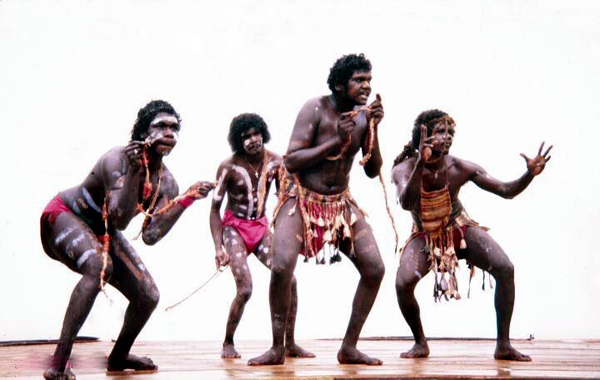 Aboriginal Australian dancers (1981) In Australia, the Indigenous populations are the Aboriginal Australian peoples (comprising many different nations and language groups) and the Torres Strait Islander peoples (also with sub-groups). These two groups are often referred to as Indigenous Australians,[190] although terms such as First Nations[191] and First Peoples are also used.[192] Pacific Islands Polynesian, Melanesian and Micronesian peoples originally populated many of the present-day Pacific Island countries in the Oceania region over the course of thousands of years. European, American, Chilean and Japanese colonial expansion in the Pacific brought many of these areas under non-Indigenous administration, mainly during the 19th century. During the 20th century, several of these former colonies gained independence and nation-states formed under local control. However, various peoples have put forward claims for Indigenous recognition where their islands are still under external administration; examples include the Chamorros of Guam and the Northern Marianas, and the Marshallese of the Marshall Islands. Some islands remain under administration from Paris, Washington, London or Wellington. 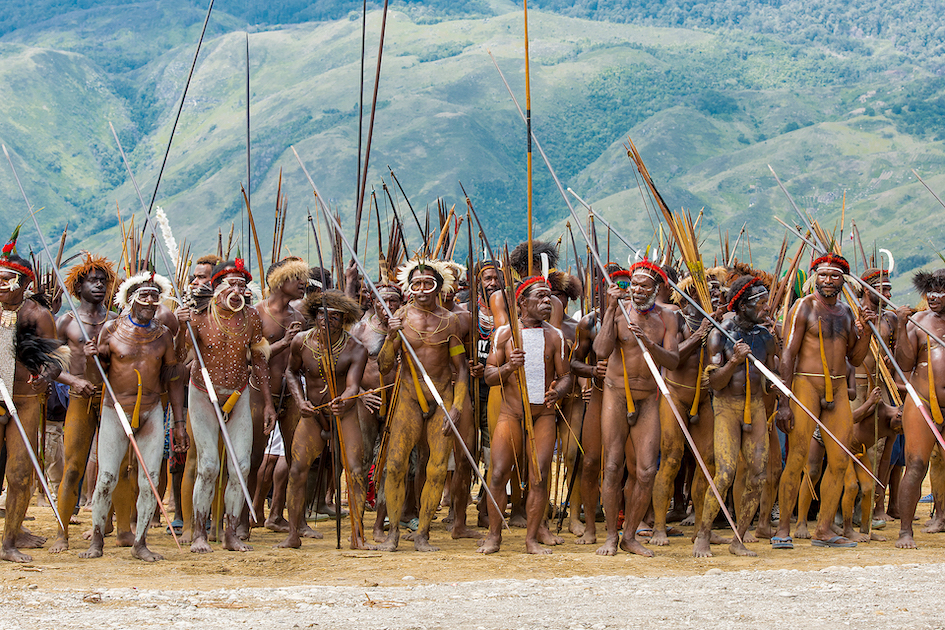 Dani people from the central highlands of western New Guinea The remains of at least 25 miniature humans, who lived between 1,000 and 3,000 years ago, were recently found on the islands of Palau in Micronesia.[193] In most parts of Oceania, Indigenous peoples outnumber the descendants of colonists. Exceptions include Australia, New Zealand and Hawaii. In New Zealand, based on various factors including census data and self-identification, the size of the population on 30 June 2021 that was full or part Māori was estimate at 17%.[194] Māori developed from Polynesian people who settled in New Zealand after migrations from other Pacific islands, probably in the 13th century.[195] Many leaders of Māori nations (iwi) signed a written agreement with the British Crown in 1840, known as the Treaty of Waitangi.[196][197][198] A majority of the Papua New Guinea population is Indigenous, with more than 700 different nationalities recognized in a total population of 8 million.[199] The country's constitution and key statutes identify traditional or custom-based practices and land tenure, and explicitly set out to promote the viability of these traditional societies within the modern state. However, conflicts and disputes concerning land use and resource rights continue between indigenous groups, the government, and corporate entities. |
地域別先住民 こちらも参照: 先住民のリスト 先住民族は世界中の地域に分布している。先住民グループの数、状況、経験は、特定の地域内でも大きく異なる場合がある。包括的な調査は、時に争いの種とな るメンバーシップや識別によってさらに複雑になる。 アフリカ 主な記事 アフリカの先住民 以下も参照のこと: Category:アフリカの先住民族 サハラ以南のアフリカ  手で火を起こす、ボツワナのサン族。  コンゴのピグミー族 ポストコロニアル時代、アフリカ大陸における特定の先住民族という概念は、論争がないわけではないが、より広く受け入れられるようになった。現代のアフリ カの独立国家のほとんどを構成する、非常に多様で多数の民族集団は、その中に様々な民族を含んでおり、その状況、文化、牧畜あるいは狩猟採集のライフスタ イルは、一般的に疎外され、国家の支配的な政治・経済構造から切り離されている。20世紀後半以降、これらの民族は、国内および国際的な文脈の中で、先住 民族としての権利の承認を求めるようになっている。 アフリカの大多数の民族は、その大陸に起源を持つという意味で「先住民族」であるが、実際には、現代の定義による先住民族としてのアイデンティティはより 限定的なものであり、すべてのアフリカの民族がこの定義によるアイデンティティを主張しているわけではない。この認識を主張する集団や共同体は、さまざま な歴史的・環境的状況によって支配的な国家システムの外に置かれた人々であり、その伝統的慣習や土地所有権は、政府や企業、周囲の支配的社会が実施する目 的や政策としばしば対立する。 北アフリカ 北アフリカの先住民族は、主にマグレブのベルベル人とナイル渓谷のコプト人、ヌビア人で構成されている。彼らの大部分は、ラシードゥン朝とウマイヤド朝の カリフによるイスラム征服の後、アラブ化された。 アメリカ大陸 主な記事 アメリカ大陸の先住民 関連項目 Category:アメリカ大陸の先住民族  カナダ、ヌナブトのドーセット岬で伝統的なカムティック(犬ぞり)に乗るイヌイット。  ベラクルス州ヨフアリチャンでナウア族の伝統的な頭飾りをかぶる少女。 アメリカ大陸の先住民族は、ヨーロッパ人による植民地化や入植が始まる以前(つまりコロンブス以前)にこの地域に居住していた集団とその子孫であると広く 認識されている。伝統的な生活様式を維持し、あるいは維持しようとしている先住民族は、北極圏の高地からティエラ・デル・フエゴの南端まで分布している。 アメリカ大陸の歴史的、そして現在進行中のヨーロッパ植民地化が先住民社会に与えた影響は、一般的に非常に深刻であり、多くの当局が、主に病気、土地の窃 盗、暴力が原因で人口が大幅に減少した範囲を推定している。多くの当局が、主に病気や土地の窃盗、暴力が原因で人口が大幅に減少していると推定している。 しかし、繁栄し、たくましく生きている先住民の国やコミュニティも数多く存在し、また過去にも存在した。 北米 北アメリカは、先住民によってアビヤ・ヤラまたはタートル・アイランドと呼ばれることもある。 メキシコでは、2015年にメキシコの総人口の9%にあたる約1,100万人が先住民であると自己申告しており、北米で最も先住民人口が多い国となってい る[97][98]。 2015年の報告では、南部のオアハカ州(65.73%)とユカタン州(65.40%)では、人口の大半が先住民である。先住民の人口が多い他の州には、 カンペチェ州(44.54%)、キンタナ・ロー州(44.44%)、イダルゴ州(36.21%)、チアパス州(36.15%)、プエブラ州 (35.28%)、ゲレロ州(33.92%)などがある[99][100]。 カナダにおける先住民族は、ファースト・ネーションズ[101]、イヌイット[102]、メティス[103]から構成されている。カナダのいくつかの全国 組織は、その名称を「アボリジニ」から「先住民」に変更した。最も顕著なのは、2015年にアボリジナル・アフェアーズ・アンド・ノーザン・ディベロップ メント・カナダ(AANDC)がインディヘナイズ・アンド・ノーザン・アフェアーズ・カナダ(INAC)に変更されたことであり、その後2017年にイン ディヘナイズ・サービス・カナダとクラウン・インディヘナイズ・リレーションズ・アンド・ノーザン・ディベロップメント・カナダに分割された[106]。 2016年の国勢調査によると、カナダには約167万人の先住民がいる。 [107]現在、クリー族、モホーク族、ミクマク族、ブラックフット族、コースト・サリッシュ族、イヌ族、デネ族など、カナダ全土に600を超える先住民 族の政府またはバンドが存在し、固有の先住民族の文化、言語、芸術、音楽を有している[108][109]。先住民族は1871年から1921年にかけ て、ブリティッシュ・コロンビアの一部を除く現在のカナダの大部分で11の条約[110]を締結した。 イヌイットは、1999年にヌナヴィク準州(ケベック州北部)、ヌナチアフト準州(ラブラドール州北部)、ヌナブト準州(1999年までノースウェスト準 州の一部)が誕生し、ある程度の行政自治を達成した。また、デンマーク王国内のグリーンランド自治領には、先住民であるヨーロッパ系グリーンランド・ノル ウェー人に代わって13世紀に入植したイヌイット(約85%)が居住しており、先住民の大多数を占めている[111][112][113][114]。 アメリカ合衆国では、ネイティブ・アメリカン、イヌイット、その他の先住民の合計人口は2,786,652人(2003年の国勢調査の数字の約1.5%を 占める)。連邦レベルで承認されている部族は563あり、州レベルで承認されている部族も多数ある。 中南米  ペルー、アンデス、聖なる谷のケチュア族の女性と子供 ボリビアでは全人口の56~70%、グアテマラ、ペルーのアンデスおよびアマゾン諸国では少なくとも人口の半分を占めると推定されている。英語では、先住 民族は地域、年齢、話者の民族によって異なる呼び名で総称され、普遍的に受け入れられる呼び名はない。一般的な呼び方ではなく、自分たちの部族や民族の具 体的な名前を使うことを好む人がほとんどである。スペイン語圏やポルトガル語圏では、índios、pueblos indígenas、amerindios、povos nativos、povos indígenas、ペルーではComunidades Nativas(先住民共同体)といった用語が使われ、特にウラリナ族[115]やマツェ族といったアマゾンの社会でよく見られる。チリでは、最も人口の 多い先住民は、中南部のマプチェ族と北部のアイマラ族である[116]。ポリネシア系民族であるイースター島のラパ・ヌイは、チリで唯一の非アメリカ系先 住民である。 先住民はブラジルの全人口の0.4%、約70万人を占める[117]。先住民はブラジルの全領土に居住しているが、その大部分は北部と中西部のインディア ン居留地に居住している。2007年1月18日、FUNAIは、ブラジル国内に67の未接触民族が存在することを確認したと発表した。この追加により、ブ ラジルはニューギニア島を抜いて、最も多くの未接触民族が存在する国となった[118]。 アジア 以下も参照のこと: Category:アジアの先住民族  パキスタンのカラシュ族の少女 西アジア アルメニア人はアルメニア高地の先住民族である[119][120][121][122]。1915年のアルメニア人大虐殺のため、現在では祖先の故郷の 外で暮らすアルメニア人の方が多い。 アラブ人はアラビア半島の先住民であり、7世紀から8世紀にかけてのイスラム教徒の征服の後、より広い中近東と北アフリカに広がった[123][124] [125]。 ポント・ギリシャ人やカッパドキア・ギリシャ人を含むアナトリア・ギリシャ人は、テュルク人が征服する数千年前からアナトリアに存在していたギリシア語を 話す少数民族である。しかし、一部はトルコに残っている[129][130]。少なくとも紀元前1000年代からアナトリアにはギリシア人が存在し [131][132]、ギリシア人商人は紀元前1900年からアナトリア西部を訪れていた[133]。 アッシリア人はメソポタミア土着の民族であり[134][135][119][136]、古代の新アッシリア帝国の末裔であり、本来の祖国であるアッシリ アに住んでいたと主張し、今でもアッシリア帝国の公用語であったアラム語の方言を話す。 コプト教徒は、エジプトとスーダンとリビアの一部に土着する民族宗教集団であり、世界最古のキリスト教共同体のひとつである[137][138]。 グルジア人はグルジア固有の民族である。 クルド人はメソポタミアの先住民族の1つである[139][140][141][142][143]。 ヤジディ教徒は上メソポタミアの先住民である[144][119][145][146][147]。 パレスチナ・アラブ人とユダヤ人が歴史的なパレスチナ/イスラエルの土地(エレズ・イスラエルとして知られる)に土着しているという競合する主張がある [148][149][150]。 19世紀と20世紀のシオニズムはユダヤ人の古代の祖国への回復を求めた[151][152][153]。この議論は1990年代にイスラエル・パレスチ ナ紛争に入り、パレスチナ人はユダヤ人入植によって追いやられた既存の住民としての先住民の地位を主張し、現在イスラエル国家において少数派を構成してい る。 [154][155]イスラエルのユダヤ人は、この土地との歴史的・宗教的なつながりを強調することで先住民の地位を主張し、この土地を祖先の故郷とみな しており、何世紀にもわたる離散と迫害の末に待望の帰還として現代イスラエルが成立したと考えている[156][157]。ユダヤ人は聖書の時代からレ ヴァント南西部に継続的に存在していたが、迫害と追放により、ローマ帝国末期にはユダヤ人は少数派となった[158][159][160][161] [162]。 2007年、ネゲヴのベドウィンは国連によって正式にイスラエルの先住民として承認された[163]。このことは、ベドウィンの先住民としての主張に異議 を唱えるイスラエル国家に関連する学者たち[164]と、アラブ民族の一グループだけを先住民として承認することは、他の人々の主張を弱め、遊牧文化を 「フェティシズム化」する危険性があると主張する学者たちの両方から批判されている[165]。 南アジア  インド北東部のナガ族 インド洋にあるインドのアンダマン・ニコバル諸島にも、海峡島のアンダマン人、ミドル・アンダマン島とサウス・アンダマン島のジャラワ人、リトル・アンダ マン島のオンゲ人、ノース・センチネル島の未接触のセンチネル人など、いくつかの先住民族が暮らしている。彼らはインド政府に登録され、保護されている。 スリランカでは、先住民族ヴェッダ人は現在、人口の少数派を占めている。  マリーナ・A・テミナ、にブフ語のネイティブスピーカー兼教師  2011年国勢調査によるインドの指定部族の割合(テシル別) 北東アジア  アイヌの伝統舞踊を踊るアイヌの男性 アイヌ民族は北海道、千島列島、サハリンの大部分に住む先住民族である。日本人の入植が拡大するにつれ、アイヌ民族は北に押しやられ、シャクシャインの乱 やメナシ・クナシルの乱で日本人と戦った。 [166]日本のアイヌ民族に関する1997年の画期的な判決において、日本の裁判所は「ある少数民族が多数民族に支配される以前からその地域に居住し、 多数民族に支配された後もその固有の民族文化を保持していたのに対し、別の少数民族が多数民族の支配に同意した後に多数民族に支配された地域に居住するよ うになった場合、前者の集団の固有の民族文化がより大きな考慮を必要とするのは当然であると認められなければならない」と述べ、彼らの主張を法律上認めた [167]。 ズンガル・オイラト族は新疆北部のズンガリアの先住民族である。 サリコリ・パミリ族は新疆タシュクルガンの先住民族である。 チベット人はチベットの先住民である。 琉球人は琉球諸島の先住民である。 済州人は韓国の済州島の先住民族である。 台湾原住民の言語は歴史言語学において重要である。なぜなら、台湾はオセアニア全域に広がったオーストロネシア語族全体の原産地であった可能性が高いから である[168][169][170]。 香港では、新界の先住民は中英共同宣言で、1898年の香港領土拡張条約以前に香港に居住していた人物の男系子孫と定義されている[171]。先住民を構 成するいくつかの異なるグループ、プンティ、客家、ホクロ、タンカがある。しかし、タンカのように、中国南部の漢民族以前の住民である白越人に遺伝的・人 類学的ルーツを持つものもいる。 ロシア人は17世紀から18世紀にかけてシベリアに侵入し、先住民族を征服した。 ニブフ族はサハリンの先住民族であり、ニブフ語を話す少数民族であるが、1990年代からのサハリンの油田開発により、彼らの漁撈文化は絶滅の危機に瀕し ている[172]。 ロシアでは、「先住民」の定義は人口数(50,000人未満)に大きく言及し、自認、侵略、植民地化、または国家境界線の確立時にその国や地域に居住して いた先住民の出自、特徴的な社会的、経済的、文化的制度などを無視したものであるとして議論されている。 [したがって、サハ、コミ、カレリアなどのロシアの先住民族は、人口規模(5万人以上)ゆえに先住民族とはみなされず、その結果「特定の法的保護の対象と はなっていない」[174]。非承認の理由は、人口の大きさと、現在の地域への出現が比較的遅かったためであり、したがってロシアの先住民は50,000 人未満であるはずである[173][175][176]。 東南アジア  ボルネオ島のダヤック族 マレー系シンガポール人はシンガポールの先住民であり、オーストロネシア人の移住以来シンガポールに居住している。彼らは13世紀にシンガプーラ王国を建 国した。シンガポール」という名称は、マレー語のシンガプーラの英語化であり、「ライオンの都市」を意味するサンスクリット語に由来する。シンガポールの 主な島のマレー語の固有名はウジョン島(Pulau Ujong)である。 ダヤック族はボルネオ島の先住民族のひとつである。ボルネオ島にある200以上の河川や丘陵に住む民族を指す緩やかな言葉であり、それぞれが独自の方言、 習慣、法律、領土、文化を持っているが、共通の特徴的な特徴は容易に識別できる。 チャム族は旧チャンパ州の先住民族であり、ナムティエン(Nam tiến)時代のチャム=ベトナム戦争でベトナムに征服された。ベトナムのチャム族は、この地域の先住民族であるにもかかわらず、ベトナム政府からは先住 民族ではなく、少数民族としてしか認められていない。 デガー(モンタニャルド)族は中央高原(ベトナム)の先住民族で、ナムティエンでベトナムに征服された。 クメール・クロムはメコンデルタとサイゴンの先住民族で、ベトナム王女と引き換えにベトナムがカンボジア国王チェ・チェタ2世から獲得した。 インドネシアには、先住民として分類される人々が5,000万人から7,000万人いる[177]。しかし、インドネシア政府は先住民の存在を認めておら ず、特定のグループには明確な文化的区別があるにもかかわらず、すべてのインドネシア先住民の民族グループを「先住民」として分類している[178]。こ の問題はASEAN地域の他の多くの国々と共通している。 フィリピンでは、135の民族言語集団が存在し、その大半が国内の主流先住民民族集団から先住民族とみなされている。フィリピンのコーディリエラ行政区と カガヤン渓谷の先住民族はイゴロット族である。ミンダナオ島の先住民族は、ルマド族とスールー諸島に住むモロ族(タウスグ族、マギンダナオ族、マラナオ族 など)である。その他、パラワン、ミンドロ、ビサヤ、ルソン島中南部にも先住民族がいる。ミャンマーは世界でも有数の先住民族人口を有する国である。 ミャンマーには、シャン族、カレン族、ラカイン族、カレンニ族、チン族、カチン族、モン族などの先住民族がいる。しかし、アカ族、リス族、ラフ族、ムルー 族など、先住民族とされる民族はもっと多い[179]。 ヨーロッパ 主な記事 ヨーロッパの民族 以下も参照のこと: ヨーロッパの遺伝史およびCategory:ヨーロッパの先住民族も参照のこと。  1936年、ラップランドのサーミ人家族 ヨーロッパには何千年もの間、さまざまな民族が暮らしてきた。しかし、先住民族という概念がヨーロッパの文脈で使われることはほとんどなく[16]、国連 がヨーロッパで先住民族として認定しているのはごくわずかである。 ヨーロッパにおける少数先住民には、ノルウェー北部、スウェーデン、フィンランド、ロシア北西部(サーミとも呼ばれる地域)のサーミ人[180] [181]、ロシア北部のネネツ人[181]、グリーンランドのイヌイットが含まれる。 [181][182]サーミ人をヨーロッパで唯一認められた先住民族と表現する資料もあり[183][184][185]、EUで唯一の先住民族と表現す る資料もある[186][187][188][189]。 特に中欧、西欧、南欧において、ソルブ人のように1989年の先住民族及び部族民条約における先住民族の記述に当てはまると考えられるその他の集団は、一 般的には代わりに国民的少数民族に分類されている[16]。 オセアニア 主な記事 オセアニアの先住民族 以下も参照: Category:オセアニアの先住民族 オーストラリア  オーストラリア先住民のダンサー(1981) オーストラリアでは、先住民はオーストラリア先住民族(多くの異なる民族と言語グループから成る)とトレス海峡諸島民族(サブグループもある)である。こ の2つのグループはしばしばオーストラリア先住民[190]と呼ばれるが、ファースト・ネーションズ[191]やファースト・ピープルズ[192]といっ た用語も使われる。 太平洋諸島 ポリネシア、メラネシア、ミクロネシアの人々は、数千年の間にオセアニア地域の現在の太平洋島嶼国の多くに居住するようになった。太平洋におけるヨーロッ パ、アメリカ、チリ、日本の植民地拡大は、主に19世紀にこれらの地域の多くを非原住民の統治下に置いた。20世紀には、これらの旧植民地の幾つかが独立 し、現地の支配の下に国民国家が形成されました。しかし、グアムや北マリアナ諸島のチャモロ人、マーシャル諸島のマーシャル人など、さまざまな民族が、自 分たちの島がまだ外部統治下にある場合、先住民の承認を求めている。グアムや北マリアナ諸島のチャモロ人、マーシャル諸島のマーシャル人などがその例であ る。  ニューギニア西部中央高地のダニ族 最近、ミクロネシアのパラオ諸島で、1,000年から3,000年前に生きていた少なくとも25人の小型人類の遺骨が発見された[193]。 オセアニアのほとんどの地域では、先住民の数が入植者の子孫の数を上回っている。例外はオーストラリア、ニュージーランド、ハワイである。ニュージーラン ドでは、国勢調査データと自認を含む様々な要因に基づき、2021年6月30日時点の人口のうち、完全または一部マオリ人である人の割合は17%と推定さ れている[194]。マオリ人は、おそらく13世紀に他の太平洋諸島から移住してきたポリネシア人からニュージーランドに定住し、発展した[195]。 パプアニューギニアの人口の大多数は先住民族であり、総人口800万人のうち700以上の異なる国籍が認められている[199]。同国の憲法と主要な法令 は、伝統的または慣習に基づく慣行と土地保有を特定し、近代国家の中でこれらの伝統的社会の存続を促進することを明確に定めている。しかし、土地利用や資 源の権利に関する対立や紛争は、先住民族グループ、政府、企業の間で続いている。 |
Indigenous
rights and other issues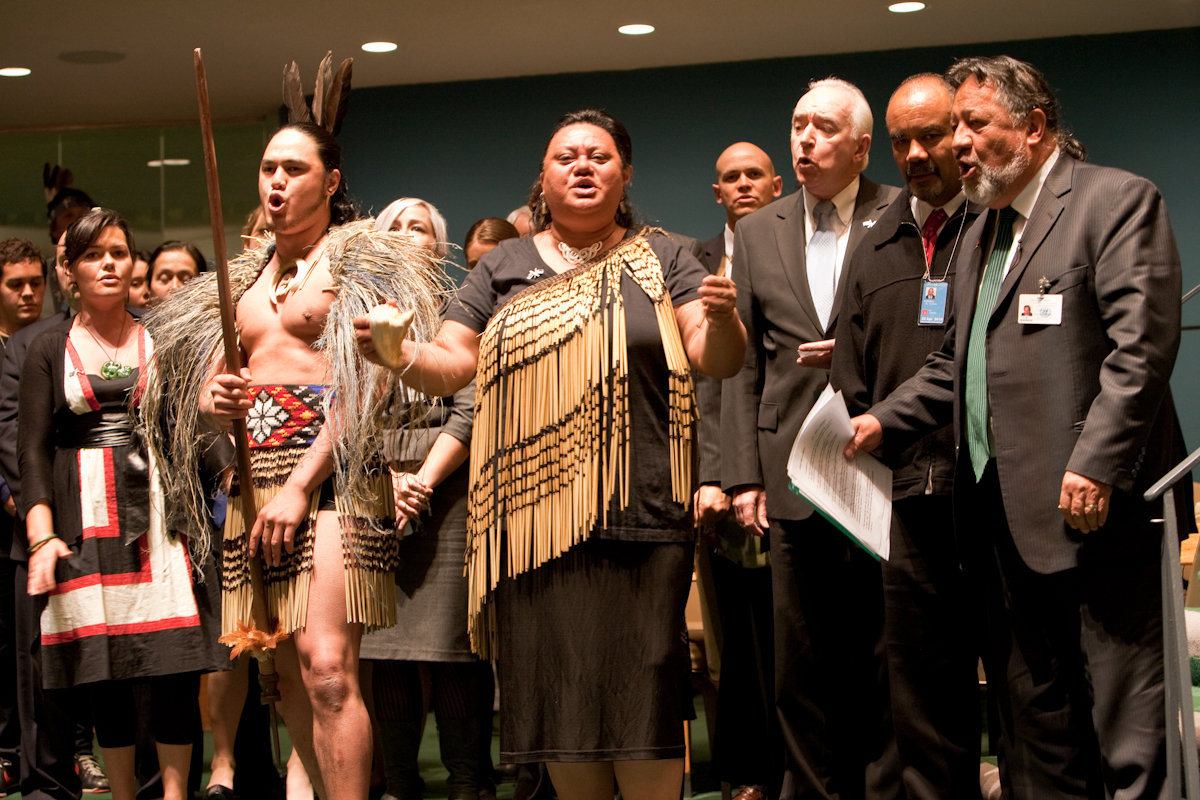 The New Zealand delegation, including Māori members, endorses the United Nations Declaration on the Rights of Indigenous Peoples in 2010. Indigenous peoples confront a diverse range of concerns associated with their status and interaction with other cultural groups, as well as changes in their inhabited environment. Some challenges are specific to particular groups; however, other challenges are commonly experienced.[200] These issues include cultural and linguistic preservation, land rights, ownership and exploitation of natural resources, political determination and autonomy, environmental degradation and incursion, poverty, health, and discrimination. The interactions between Indigenous and non-Indigenous societies throughout history and contemporarily have been complex, ranging from outright conflict and subjugation to some degree of mutual benefit and cultural transfer. A particular aspect of anthropological study involves investigation into the ramifications of what is termed first contact, the study of what occurs when two cultures first encounter one another. The situation can be further confused when there is a complicated or contested history of migration and population of a given region, which can give rise to disputes about primacy and ownership of the land and resources. Wherever Indigenous cultural identity is asserted, common societal issues and concerns arise. These concerns are often not unique to Indigenous groups. Despite the diversity of Indigenous peoples, they share common problems and issues in dealing with the prevailing, or invading, society. They are generally concerned that the cultures and lands of Indigenous peoples are being lost and that Indigenous peoples suffer both discrimination and pressure to assimilate into the surrounding or colonizing societies. This is borne out by the fact that the lands and cultures of nearly all of the peoples listed at the end of this article are under threat. Notable exceptions are the Sakha and Komi peoples (two northern Indigenous peoples of Russia), who now control their own autonomous republics within the Russian state, and the Canadian Inuit, who form a majority of the territory of Nunavut (created in 1999). Despite the control of their territories, many Sakha people have lost their lands as a result of the Russian Homestead Act, which allows any Russian citizen to own any land in the Far Eastern region of Russia. In Australia, a landmark case, Mabo v Queensland (No 2),[201] saw the High Court of Australia reject the idea of terra nullius. This rejection ended up recognizing that there was a pre-existing system of law practiced by the Meriam people. A 2009 United Nations publication says:[33] Although indigenous peoples are often portrayed as a hindrance to development, their cultures and traditional knowledge are also increasingly seen as assets. It is argued that it is important for the human species as a whole to preserve as wide a range of cultural diversity as possible, and that the protection of indigenous cultures is vital to this enterprise. |
先
住民の権利とその他の課題(→「政治
的アイデンティティとしての先住民」) マオリ族を含むニュージーランド代表団は、2010年の「先住民族の権利に関する国連宣言」を支持。 先住民族は、その居住環境の変化だけでなく、その地位や他の文化的集団との相互作用に関連する多様な懸念に直面している。これらの問題には、文化と言語の 保護、土地の権利、天然資源の所有と利用、政治的決定と自治、環境の悪化と侵略、貧困、健康、差別などが含まれる[200]。 先住民社会と非先住民社会との相互作用は、歴史的にも現代においても複雑であり、明白な対立や被支配から、ある程度の相互利益や文化的移転に至るまで様々 である。人類学研究の特殊な側面は、ファーストコンタクトと呼ばれる、2つの文化が初めて遭遇した時に何が起こるかという研究の影響を調査することであ る。ある地域に複雑な移住の歴史や争いの歴史があり、土地や資源の優先権や所有権に関する争いが生じると、状況はさらに混乱する。 先住民の文化的アイデンティティが主張されるところではどこでも、共通の社会問題や懸念が生じる。こうした懸念は多くの場合、先住民族特有のものではな い。先住民族は多様であるにもかかわらず、一般社会、あるいは侵略社会に対処する上で共通の問題や課題を抱えている。彼らは一般的に、先住民族の文化や土 地が失われつつあること、先住民族が差別と周辺社会や植民地化する社会への同化圧力の両方に苦しんでいることを懸念している。このことは、この記事の最後 に挙げたほぼすべての民族の土地と文化が脅威にさらされているという事実が証明している。特筆すべき例外は、サハ族とコミ族(ロシア北部の2つの先住民 族)で、彼らは現在、ロシア国家内の自治共和国を支配している。領土を支配しているにもかかわらず、ロシアのホームステッド法(ロシア国民であれば誰でも ロシア極東地域の土地を所有できる)の結果、多くのサハ人が土地を失っている。オーストラリアでは、Mabo v. Queensland (No 2)[201]という画期的な裁判で、オーストラリア高等法院がテラ・ヌリウスの考え方を否定した。この棄却は、結局のところ、メリアム人によって実践さ れていた既存の法制度が存在したことを認めることになった。 2009年の国連の発表によると、以下の通りである[33]。 先住民族はしばしば開発の障害として描かれるが、その文化や伝統的知識は資産とみなされることも増えている。人類全体にとって、文化的多様性を可能な限り 幅広く維持することが重要であり、そのためには先住民族の文化を保護することが不可欠であると主張されている。 |
Human rights violations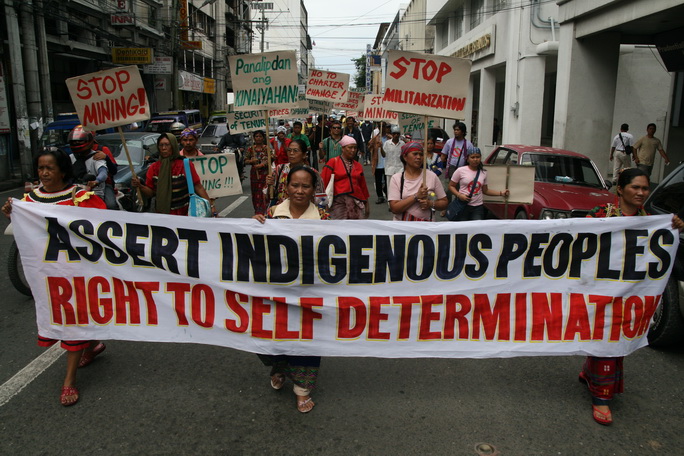 Indigenous peoples march for their right to self-determination in Davao City (2008). The Bangladeshi Government has stated that there are "no indigenous peoples in Bangladesh".[202] This statement has angered the Indigenous peoples of Chittagong Hill Tracts, Bangladesh, collectively known as the Jumma.[203] Experts have protested against this move of the Bangladesh Government and have questioned the Government's definition of the term "indigenous peoples".[204][205] This move by the Bangladesh Government is seen by the Indigenous peoples of Bangladesh as another step by the Government to further erode their already limited rights.[206] Hindu Chams and Muslim Chams have both experienced religious and ethnic persecution and restrictions on their faith under the current Vietnamese government, with the Vietnamese state confiscating Cham property and forbidding Cham from observing their religious beliefs. Hindu temples were turned into tourist sites against the wishes of the Cham Hindus. In 2010 and 2013 several incidents occurred in Thành Tín and Phươc Nhơn villages where Cham were murdered by Vietnamese. In 2012, Vietnamese police in Chau Giang village stormed into a Cham Mosque, stole the electric generator, and also raped Cham girls.[207] Cham in the Mekong Delta have also been economically marginalized, with ethnic Vietnamese settling on land previously owned by Cham people with state support.[208] The Indonesian government has outright denied the existence of Indigenous peoples within the countries' borders. In 2012, Indonesia stated that 'The Government of Indonesia supports the promotion and protection of indigenous people worldwide ... Indonesia, however, does not recognize the application of the indigenous peoples concept ... in the country'.[209] Along with the brutal treatment of the country's Papuan people (a conservative estimate places the violent deaths at 100,000 people in West New Guinea since Indonesian occupation in 1963, see Papua Conflict) has led to Survival International condemning Indonesia for treating its Indigenous peoples as the worst in the world.[209] The Vietnamese viewed and dealt with the Indigenous Montagnards from the Central Highlands of Vietnam as "savages", which caused a Montagnard uprising against the Vietnamese.[210] The Vietnamese were originally centered around the Red River Delta but engaged in conquest and seized new lands such as Champa, the Mekong Delta (from Cambodia) and the Central Highlands during Nam Tien. While the Vietnamese received strong Chinese influence in their culture and civilization and were Sinicized, and the Cambodians and Laotians were Indianized, the Montagnards in the Central Highlands maintained their own Indigenous culture without adopting external culture and were the true Indigenous of the region. To hinder encroachment on the Central Highlands by Vietnamese nationalists, the term Pays Montagnard du Sud-Indochinois (PMSI) emerged for the Central Highlands along with the indigenous being addressed by the name Montagnard.[211] The tremendous scale of Vietnamese Kinh colonists flooding into the Central Highlands has significantly altered the demographics of the region.[212] The anti-ethnic minority discriminatory policies by the Vietnamese, environmental degradation, deprivation of lands from the Indigenous people, and settlement of Indigenous lands by an overwhelming number of Vietnamese settlers led to massive protests and demonstrations by the Central Highland's indigenous ethnic minorities against the Vietnamese in January–February 2001. This event gave a tremendous blow to the claim often published by the Vietnamese government that in Vietnam "There has been no ethnic confrontation, no religious war, no ethnic conflict. And no elimination of one culture by another."[213] 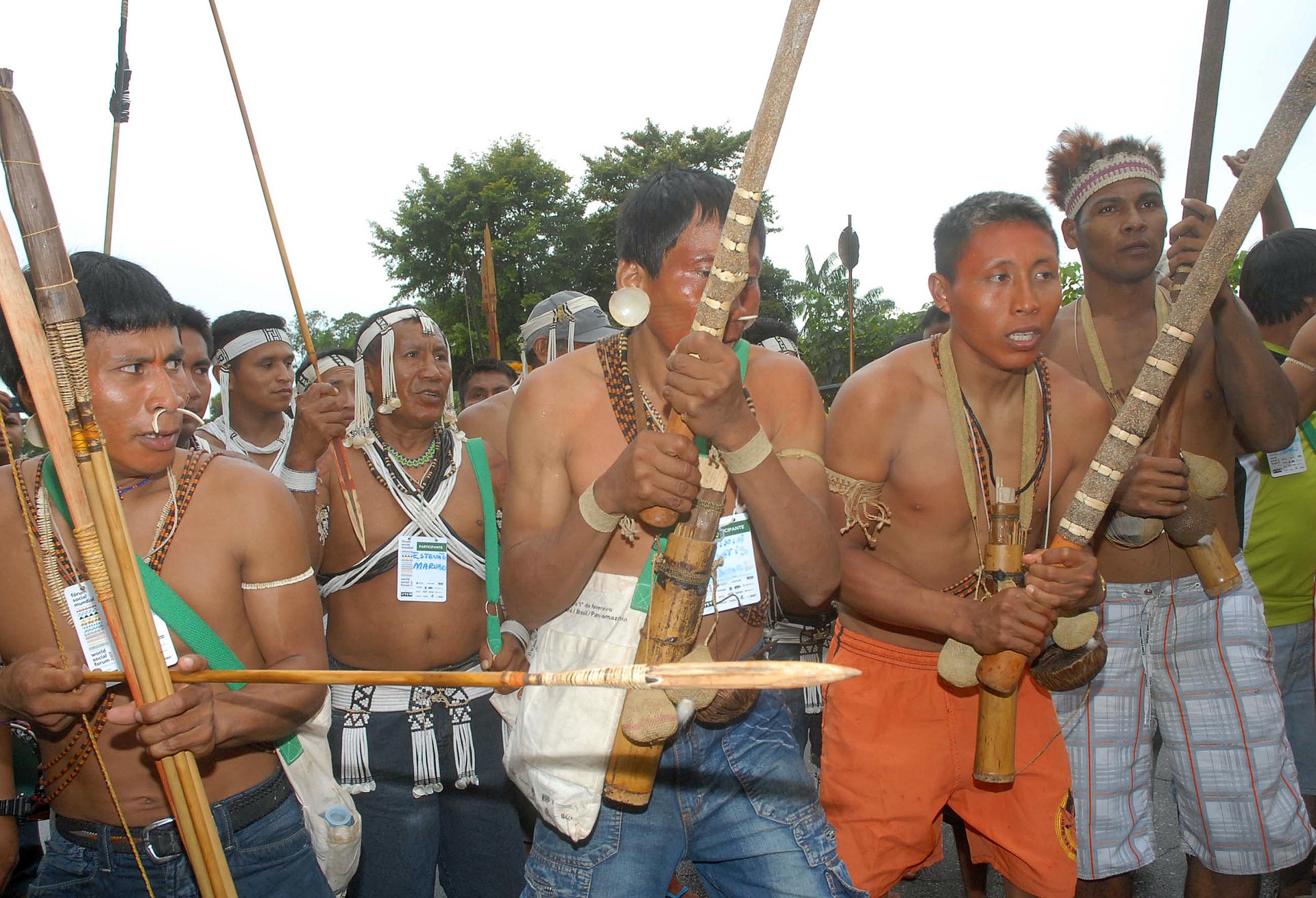 Indigenous protesters from Vale do Javari, one of the largest indigenous territories in Brazil In May 2016, the Fifteenth Session of the United Nations Permanent Forum on Indigenous Issues (UNPFII) affirmed that Indigenous peoples are distinctive groups protected in international or national legislation as having a set of specific rights based on their linguistic and historical ties to a particular territory, prior to later settlement, development, and or occupation of a region.[214] The session affirms that, since Indigenous peoples are vulnerable to exploitation, marginalization, oppression, forced assimilation, and genocide by nation states formed from colonizing populations or by different, politically dominant ethnic groups, individuals and communities maintaining ways of life indigenous to their regions are entitled to special protection. The Indigenous people from Tanzania's Maasai community were reportedly subjected to eviction from their ancestral land to make way for a luxury game reserve by Otterlo Business Corporation in June 2022. The game reserve was reportedly being set up for the royals of the United Arab Emirates also linked to OBC or the Otterlo Business Corporation. According to lawyers and human rights groups and activists, approximately 30 Maasai people were injured by security forces in the process of eviction and delimiting a land area of 1500 km2. A 2019 UN report has described OBC as a 'UAE-based' luxury-game hunting company, granted a license to hunt by the Tanzanian government in 1992 for "the UAE royal family to organize private hunting trips", denying the Maasai people access to their own land.[215] |
人権侵害 ダバオ市で自己決定権を求めて行進する先住民(2008年)。 バングラデシュ政府は、「バングラデシュに先住民族は存在しない」と表明している[202]。この発言は、ジュマと総称されるバングラデシュのチッタゴ ン・ヒル・トラクトの先住民族を怒らせている。 [専門家たちはバングラデシュ政府のこの動きに抗議し、政府の「先住民族」という用語の定義に疑問を呈している[204][205]。バングラデシュ政府 のこの動きは、バングラデシュの先住民族にとっては、すでに制限されている彼らの権利をさらに侵食する政府の新たな一歩と見られている[206]。 ヒンドゥー教徒のチャム族とイスラム教徒のチャム族は共に、現ベトナム政府下で宗教的・民族的迫害と信仰に対する制限を経験しており、ベトナム国家はチャ ム族の財産を没収し、チャム族が宗教的信仰を守ることを禁じている。ヒンドゥー寺院は、チャムヒンドゥー教徒の意に反して観光地化された。2010年と 2013年には、タイン・ティン村とフオック・ニュン村でチャム族がベトナム人に殺害される事件が発生した。2012年には、チャウ・ザン村のベトナム人 警察がチャム族のモスクに押し入り、発電機を盗み、チャム族の少女を強姦した[207]。メコンデルタのチャム族も経済的に疎外されており、以前はチャム 族が所有していた土地にベトナム民族が国の支援を受けて定住している[208]。 インドネシア政府は、国境内の先住民族の存在を真っ向から否定している。2012年、インドネシアは「インドネシア政府は世界中の先住民族の促進と保護を 支持する。しかしインドネシアは、国内における...先住民族の概念の適用を認めていない」と述べている[209]。同国のパプア人に対する残虐な扱い (控えめに見積もっても、1963年のインドネシア占領以来、西ニューギニアで10万人が暴力的な死を遂げている。 ベトナム人はベトナム中央高原の先住民モンタニャードを「野蛮人」とみなし、扱ったため、ベトナム人に対するモンタニャードの反乱を引き起こした [210]。ベトナム人はもともと紅河デルタを中心としていたが、征服に従事し、チャンパ、(カンボジアからの)メコンデルタ、ナムティエンの間の中央高 原などの新しい土地を奪った。ベトナム人は文化や文明に中国の強い影響を受けて中国化し、カンボジア人やラオス人はインド化したが、中央高原のモンタニャ ルド人は外部文化を取り入れることなく独自の土着文化を維持し、この地域の真の土着人であった。ベトナム人ナショナリストによる中央高地への侵入を防ぐた め、先住民をモンタニャードの名で呼ぶとともに、中央高地をPays Montagnard du Sud-Indochinois(PMSI)と呼ぶようになった[211]。中央高地に押し寄せた途方もない規模のベトナム人キン族入植者は、この地域の 人口動態を大きく変化させた。 [212]ベトナム人による反少数民族差別政策、環境悪化、先住民からの土地の収奪、圧倒的な数のベトナム人入植者による先住民の土地への入植は、 2001年1月から2月にかけての中央高原の先住民少数民族によるベトナム人に対する大規模な抗議とデモにつながった。この出来事は、ベトナム政府がしば しば発表する「ベトナムには民族対立も宗教戦争も民族紛争もない。また、ある文化が別の文化によって排除されたこともない」[213]。  ブラジル最大級の先住民領土であるヴァーレ・ド・ジャヴァリの先住民抗議者たち 2016年5月、国連先住民族問題に関する常設フォーラム(UNPFII)第15回会合は、先住民族とは、後にその地域に定住、開発、または占領される以 前の、特定の領土との言語的、歴史的な結びつきに基づく一連の特定の権利を有するものとして、国際法または国内法で保護される特徴的な集団であることを確 認した。 [先住民族は、植民地化した人々や政治的に支配的な異なる民族集団から形成された国家による搾取、疎外、抑圧、同化の強要、大量虐殺の被害を受けやすいた め、その地域固有の生活様式を維持する個人やコミュニティは特別な保護を受ける権利がある。 タンザニアのマサイ族コミュニティの先住民は、2022年6月、オッテルロ・ビジネス・コーポレーションによる高級狩猟保護区建設のため、先祖伝来の土地 からの立ち退きを迫られたと報じられている。この狩猟保護区は、OBC(オッテルロ・ビジネス・コーポレーション)ともつながりのあるアラブ首長国連邦の 王族のために設置されると報じられている。弁護士や人権団体、活動家によると、約30人のマサイ族が、立ち退きと1500km2の土地面積を画定する過程 で、治安部隊によって負傷したという。2019年の国連報告書によると、OBCは「UAEを拠点とする」高級狩猟会社であり、1992年に「UAE王族が 私的な狩猟旅行を企画する」ためにタンザニア政府から狩猟免許を与えられ、マサイ族が自分たちの土地を利用することを拒否している[215]。 |
| Health issues In December 1993, the United Nations General Assembly proclaimed the International Decade of the World's Indigenous People, and requested UN specialized agencies to consider with governments and indigenous people how they can contribute to the success of the Decade of Indigenous People, commencing in December 1994. As a consequence, the World Health Organization, at its Forty-seventh World Health Assembly, established a core advisory group of Indigenous representatives with special knowledge of the health needs and resources of their communities, thus beginning a long-term commitment to the issue of the health of Indigenous peoples.[216] The World Health Organization noted in 2003 that "Statistical data on the health status of indigenous peoples is scarce. This is especially notable for indigenous peoples in Africa, Asia and eastern Europe", but snapshots from various countries (where such statistics are available) show that indigenous people are in worse health than the general population, in advanced and developing countries alike: higher incidence of diabetes in some regions of Australia;[217] higher prevalence of poor sanitation and lack of safe water among Twa households in Rwanda;[218] a greater prevalence of childbirths without prenatal care among ethnic minorities in Vietnam;[219] suicide rates among Inuit youth in Canada are eleven times higher than the national average;[220] infant mortality rates are higher for Indigenous peoples everywhere.[221] The first UN publication on the State of the World's Indigenous Peoples revealed alarming statistics about indigenous peoples' health. Health disparities between indigenous and non-indigenous populations are evident in both developed and developing countries. Native Americans in the United States are 600 times more likely to acquire tuberculosis and 62% more likely to commit suicide than the non-Indian population. Tuberculosis, obesity, and type 2 diabetes are major health concerns for the indigenous in developed countries.[222] Globally, health disparities touch upon nearly every health issue, including HIV/AIDS, cancer, malaria, cardiovascular disease, malnutrition, parasitic infections, and respiratory diseases, affecting indigenous peoples at much higher rates. Many causes of Indigenous children's mortality could be prevented. Poorer health conditions amongst indigenous peoples result from longstanding societal issues, such as extreme poverty and racism, but also the intentional marginalization and dispossession of Indigenous peoples by dominant, non-Indigenous populations and societal structures.[222] |
健康問題 1993年12月、国連総会は「国際先住民の10年」を宣言し、国連の専門機関に対し、1994年12月から始まる「先住民の10年」の成功にどのように 貢献できるかを各国政府や先住民とともに検討するよう要請した。その結果、世界保健機関(WHO)は第47回世界保健総会において、地域社会の保健上の ニーズと資源に関する特別な知識を持つ先住民の代表からなる中核的諮問グループを設置し、先住民の保健問題への長期的な取り組みを開始した[216]。 世界保健機関は2003年に、「先住民の健康状態に関する統計データは乏しい。これは特にアフリカ、アジア、東ヨーロッパの先住民について顕著である」と 述べているが、(そのような統計がある)様々な国のスナップショットを見ると、先進国でも発展途上国でも、先住民の健康状態は一般人口よりも悪いことがわ かる: オーストラリアの一部の地域では糖尿病の罹患率が高い[217]。ルワンダのトワ族の世帯では、劣悪な衛生環境と安全な水の不足の有病率が高い [218]。ベトナムの少数民族では、出産前のケアを受けずに出産する有病率が高い[219]。カナダのイヌイットの若者の自殺率は全国平均の11倍であ る[220]。 [221] 国連が初めて発表した『世界の先住民の現状』では、先住民の健康に関する憂慮すべき統計が明らかにされた。先住民と非先住民の健康格差は、先進国でも発展 途上国でも明らかである。アメリカの先住民は、非先住民に比べて結核にかかる確率が600倍、自殺する確率が62%も高い。結核、肥満、2型糖尿病は、先 進国における先住民の主要な健康問題である[222]。世界的に見ても、健康格差は、HIV/AIDS、がん、マラリア、心血管疾患、栄養不良、寄生虫感 染症、呼吸器疾患など、ほぼすべての健康問題に関連しており、先住民はより高い割合で影響を受けている。先住民の子どもたちの死亡の原因の多くは、防ぐこ とができる。先住民の健康状態の悪化は、極度の貧困や人種差別といった長年の社会問題から生じているだけでなく、支配的な非先住民の集団や社会構造による 先住民の意図的な疎外や収奪からも生じている[222]。 |
Racism and discrimination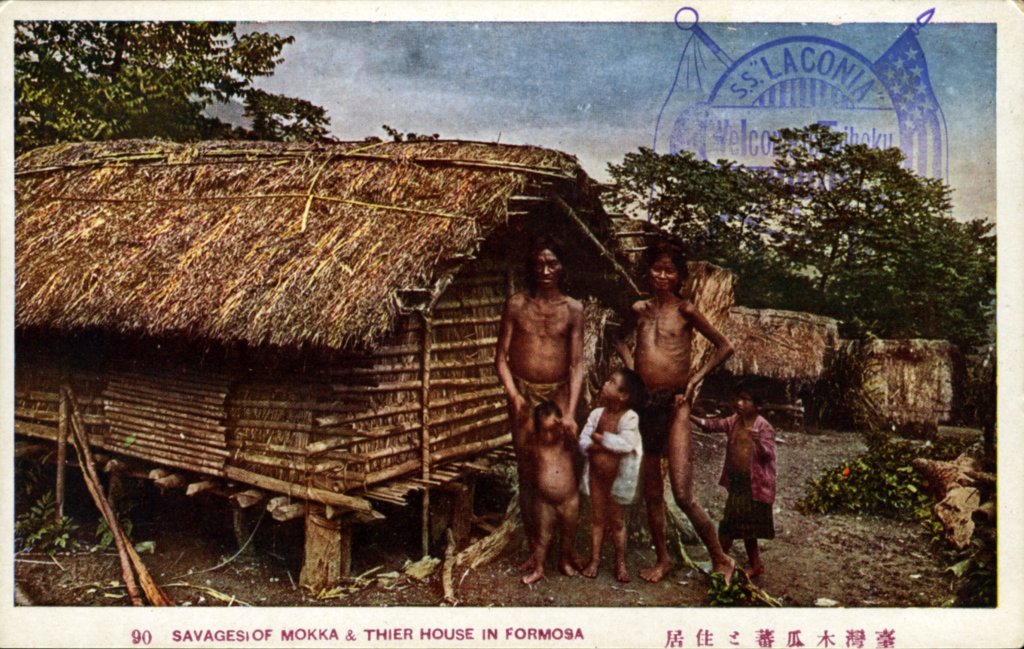 "Savages of Mokka and Their House in Formosa", pre-1945, Taiwan under Japanese rule Indigenous peoples have frequently been subjected to various forms of racism and discrimination. Indigenous peoples have been denoted as being barbaric, primitive, savage[223] or uncivilized. These terms were commonly used during the heyday of European colonial expansion, and they are still being used by certain societies in modern times.[224] During the 17th century, Europeans commonly labeled Indigenous peoples "uncivilized". Some philosophers, such as Thomas Hobbes (1588-1679), considered Indigenous people mere "savages". Others (especially literary figures in the 18th century) popularized the concept of "noble savages". Those who were close to the Hobbesian view tended to believe that they had a duty to "civilize" and "modernize" the Indigenous. Survival International runs a campaign to stamp out media portrayals of Indigenous peoples as "primitives" or "savages".[225] After World War I (1914-1918), many Europeans came to doubt the morality of the means which were used to "civilize" peoples. At the same time, the anti-colonial movement, and advocates for the rights of Indigenous peoples, argued that words such as "civilized" and "savage" were products and tools of colonialism, and they also argued that colonialism itself was savagely destructive. In the mid-20th century, European attitudes began to shift to the view that Indigenous and tribal peoples are the only peoples who should have the right to decide what should happen to their ancient cultures and their ancestral lands.[226] |
人種差別と差別 「モッカの『野蛮人』」1945年以前、日本統治下の台湾の絵葉書。 先住民は、しばしば様々な形態の人種差別や差別を受けてきた。先住民は野蛮、原始的、未開[223]、あるいは未開であるとされてきた。これらの用語は ヨーロッパの植民地拡大全盛期によく使われたものであり、現代でも特定の社会で使われている[224]。 17世紀、ヨーロッパ人は先住民に「未開」のレッテルを貼るのが一般的であった。トマス・ホッブズ(1588-1679)のような哲学者の中には、先住民 を単なる「野蛮人」と見なした者もいた。また、「高貴な野蛮人」という概念を広めた人々(特に18世紀の文学者)もいた。ホッブズの考えに近い人々は、先 住民を「文明化」し「近代化」する義務があると考える傾向があった。 サバイバル・インターナショナルは、先住民を「原始人」や「未開人」として描くメディアを一掃するキャンペーンを実施している[225]。 第一次世界大戦(1914年~1918年)後、多くのヨーロッパ人は、先住民を「文明化」するために用いられた手段の道徳性を疑うようになった。同時に、 反植民地運動や先住民の権利を擁護する人々は、「文明化」や「野蛮」といった言葉は植民地主義の産物であり道具であると主張し、植民地主義自体が野蛮なま でに破壊的であるとも主張した。20世紀半ばには、ヨーロッパ人の態度は、先住民や部族の人々こそが、彼らの古くからの文化や先祖伝来の土地に何が起こる べきかを決定する権利を持つべき唯一の民族であるという見解へと変化し始めた[226]。 |
| Cultural appropriation New Age and Neopagan adherents often look to the cultures of Indigenous peoples seeking to find ancient traditional truths and spiritual practices to appropriate into their lifestyles and worldviews.[227] |
文化の流用 ニューエイジやネオペイガンの信奉者たちは、自分たちのライフスタイルや世界観に取り入れるべき古代の伝統的真理や精神的実践を見出そうと、先住民の文化 に目を向けることが多い[227]。 |
Environmental injustice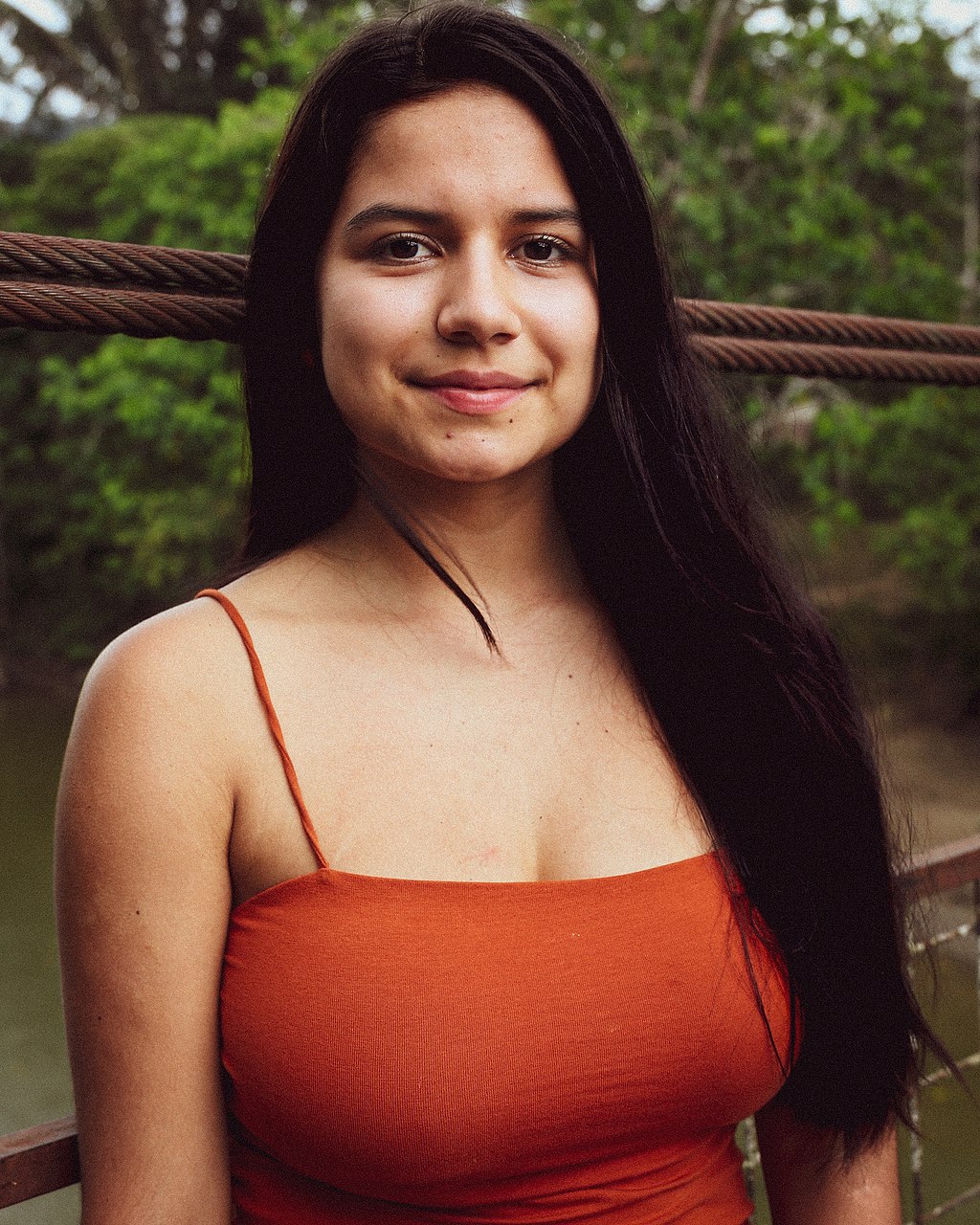 Helena Gualinga, an indigenous environmental and human rights activist[228] At an international level, Indigenous peoples have received increased recognition of their environmental rights since 2002, but few countries respect these rights in reality. The UN Declaration on the Rights of Indigenous Peoples, adopted by the General Assembly in 2007, established Indigenous peoples' right to self-determination, stating rights to manage natural resources, and cultural and intellectual property. In countries where these rights are recognized, land titling and demarcation procedures are often put on delay, or leased out by the state as concessions for extractive industries without consulting Indigenous communities.[222] Many in the United States federal government are in favor of exploiting oil reserves in the Arctic National Wildlife Refuge, where the Gwich'in Indigenous people rely on herds of caribou. Oil drilling could destroy thousands of years of culture for the Gwich'in. On the other hand, some of the Inupiat people, from another Indigenous community in the region, favor oil drilling because they could benefit economically.[229] The introduction of industrial agricultural technologies such as fertilizers, pesticides, and large plantation schemes have destroyed ecosystems that Indigenous communities formerly depended on, forcing resettlement. Development projects such as dam construction, pipelines and resource extraction have displaced large numbers of Indigenous peoples, often without providing compensation. Governments have forced Indigenous peoples off of their ancestral lands in the name of ecotourism and national park development. Indigenous women are especially affected by land dispossession because they must walk longer distances for water and fuel wood. These women also become economically dependent on men when they lose their livelihoods. Indigenous groups asserting their rights has most often resulted in torture, imprisonment, or death.[222] The building of dams can hurt Indigenous peoples by hurting the ecosystems that provide them water, food. For example, the Munduruku people in the Amazon rainforest are opposing the building of Tapajós dam[230] with the help of Greenpeace.[citation needed] Most Indigenous populations are already subject to the deleterious effects of climate change. Climate change has not only environmental, but also human rights and socioeconomic implications for Indigenous communities. The World Bank acknowledges climate change as an obstacle to Millennium Development Goals, notably the fight against poverty, disease, and child mortality, in addition to environmental sustainability.[222] |
環境不公正 先住民の環境・人権活動家、ヘレナ・グアリンガ[228]。 国際レベルでは、2002年以降、先住民の環境権に対する認識が高まっているが、現実にこれらの権利を尊重している国はほとんどない。2007年に国連総 会で採択された「先住民族の権利に関する国連宣言」では、先住民族の自決権、天然資源を管理する権利、文化的・知的財産権を明記している。このような権利 が認められている国では、土地の権利付与や区画整理の手続きが後回しにされたり、先住民のコミュニティに相談することなく、採掘産業のための租借地として 国から貸し出されたりすることが多い[222]。 アメリカ連邦政府の多くは、北極圏国立野生生物保護区に埋蔵されている石油の採掘に賛成している。石油掘削はグウィッチン族の数千年にわたる文化を破壊し かねない。その一方で、この地域のもうひとつの先住民コミュニティであるイヌピアトの人々の中には、経済的な利益を得ることができるため、石油掘削に賛成 する者もいる[229]。 肥料や農薬、大規模なプランテーション計画などの工業的農業技術の導入は、先住民コミュニティがかつて依存していた生態系を破壊し、再定住を余儀なくさせ た。ダム建設、パイプライン、資源採掘などの開発プロジェクトは、多くの場合補償を提供することなく、多数の先住民族を移住させてきた。政府はエコツーリ ズムや国立公園開発の名目で、先住民族を先祖伝来の土地から強制的に追い出してきた。先住民族の女性は、水や燃料となる薪を得るために長い距離を歩かなけ ればならないため、土地を奪われることで特に影響を受ける。また、生計を立てられなくなった女性たちは、男性に経済的に依存するようになる。先住民グルー プが自分たちの権利を主張した結果、拷問や投獄、死亡に至ることがほとんどである[222]。 ダムの建設は、彼らに水や食料を供給する生態系を傷つけることによって、先住民族を苦しめる可能性がある。例えば、アマゾンの熱帯雨林に住むムンドゥルク 族は、グリーンピースの協力を得て、タパジョス・ダムの建設に反対している[230]。 ほとんどの先住民は、すでに気候変動の悪影響を受けている。気候変動は環境だけでなく、先住民の人権や社会経済にも影響を及ぼす。世界銀行は、気候変動が ミレニアム開発目標、特に環境の持続可能性に加え、貧困、疾病、子どもの死亡率との闘いに対する障害であることを認めている[222]。 |
| Knowledge reconstruction The Western and Eastern Penan people are two major groups of Indigenous populations in Malaysia. The Eastern Penan are famous for their resistance to loggers threatening their natural resources, specifically Sago palms and various fruit bearing trees. Because of the Penan's international fame, environmentalists often visited the area to document such happenings and learn more about and from the people there, including their perspective on the land's invasion. While Indigenous people comprise less than 5% of the population, they caretake for over 80% of global biodiversity. [234] Environmentalists such as Davis and Henley, who Brosius writes lumped all native groups of Malaysia into one homogeneous group with the same ideas and traditions, and lacked dialectical connections needed to deeply understand the Penan, lacked full knowledge of the situation's specific weight to the Indigenous peoples.[235] The two embarked on a mission, stating they wished to help with conservation of the Penan's land resources, but Brosious states they were among the many who repackaged traditional knowledge into something that fit a Western narrative and agenda, and that Davis and Henley romanticized and misconstrued the traditional Penan concept of molong (meaning: "to preserve" – the Penan marked trees for personal use and to preserve them for future harvesting of fruits or for materials).[235] Another common occurrence is to extend Indigenous knowledge beyond its limits and into unrelated meanings that western consumers find spiritually profound. This tendency of journalists extends beyond Davis and Henley. It serves non-Natives to add a narrative and value beyond that which already exists within the knowledge base of Indigenous peoples. Not only do these fictionalized accounts of some Indigenous knowledge and traditions skew the beliefs of onlookers, but they also contribute to cultural genocide as the actual spiritual and religious beliefs of the Indigenous people are disappeared and replaced with the westernized fiction.[235] |
知識の再構築 西ペナン族と東ペナン族はマレーシアの先住民の2大グループである。東部ペナン族は、彼らの自然資源、特にサゴヤシやさまざまな果樹を脅かす伐採業者に対 する抵抗で有名である。ペナン族の国際的な名声のため、環境保護活動家たちはしばしばこの地域を訪れ、このような出来事を記録し、土地の侵略に対する彼ら の視点を含め、そこに住む人々について、また彼らから多くを学んだ。先住民は人口の5%にも満たないが、世界の生物多様性の80%以上を管理している。 [234] デイヴィスやヘンリーのような環境保護主義者は、マレーシアのすべての先住民族を同じ思想と伝統を持つ同質的な集団としてひとくくりにし、ペナン族を深く 理解するために必要な弁証法的なつながりを欠いていたとブロシウスは書いているが、先住民族に特有の状況の重みを十分に理解していなかった。 [235]2人はペナンの土地資源の保護に協力したいと言ってミッションに乗り出したが、彼らは伝統的な知識を西洋の物語やアジェンダに合うように再パッ ケージ化した多くの人々の一人であり、デイヴィスとヘンリーはペナンの伝統的な概念であるモロン(molong、「保存する」という意味: 「ペナン人は個人的な使用のために樹木に印をつけ、将来の果実の収穫や資材のために保存していた)[235]。 もうひとつよくあるのは、先住民の知識をその限界を超えて、西洋の消費者が精神的に深遠だと感じるような、関係のない意味に拡張することである。ジャーナ リストのこの傾向は、デイヴィスやヘンリー以外にも及んでいる。先住民の知識基盤の中にすでに存在するものを超えて、物語や価値を付加することは、非先住 民のためになる。先住民の知識や伝統の一部をフィクションとして説明することは、見物人の信念を歪めるだけでなく、先住民の実際の精神的・宗教的信念が消 え去り、西洋化されたフィクションに取って代わられることで、文化的ジェノサイドの一因にもなっている[235]。 |
| Use of indigenous knowledge Main article: Traditional knowledge 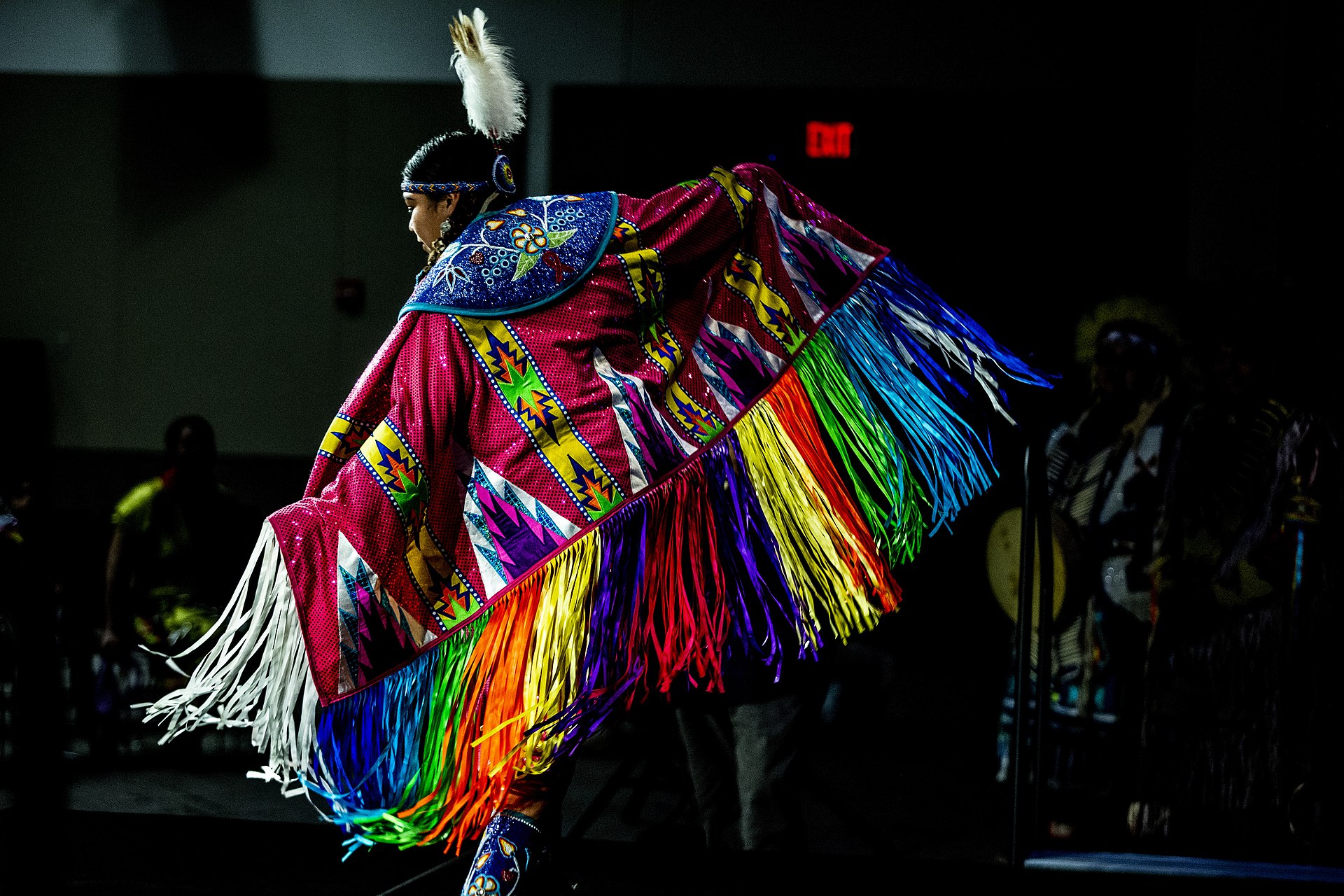 Native American dancer of the Save Our Ancestors Remains and Resources Indigenous Network Group (SOARRING) Foundation, a not-for-profit organization whose mission is to educate people about Indigenous ways of life Indigenous knowledge is considered as very important for issues linked with sustainability.[231][232] Professor Martin Nakata is a pioneer in the field of bringing indigenous knowledge to mainstream academics and media through digital documentation of unique contributions by aboriginal people.[233] |
先住民の知識の利用 主な記事 伝統的知識  先住民の生活様式についての教育を使命とする非営利団体、Save Our Ancestors Remains and Resources Indigenous Network Group(SOARRING)財団のネイティブアメリカンのダンサー。 先住民の知識は、持続可能性に関連する問題にとって非常に重要であると考えられている[231][232]。マーティン・ナカタ教授は、先住民によるユ ニークな貢献のデジタル文書化を通じて、先住民の知識を主流派の学者やメディアに広めた先駆者である[233]。 |
| Collective rights -> Individual and group rights Colonialism Cultural appropriation Ethnic minority Ecotourism § Impact on Indigenous people and Indigenous land Genocide of Indigenous peoples Human rights The Image Expedition Indigenism Indigenous Futurisms Indigenous intellectual property Indigenous Peoples Climate Change Assessment Initiative Indigenous rights Intangible cultural heritage International Day of the World's Indigenous Peoples National Indigenous Peoples Day, Canada Indigenous Peoples' Day (United States) Isuma List of active non-governmental organizations of national minorities, Indigenous and diasporas List of ethnic groups List of Indigenous peoples Missing and murdered Indigenous women Uncontacted peoples United Nations Permanent Forum on Indigenous Issues Unrepresented Nations and Peoples Organization Virgin soil epidemic |
集団的権利→個人と集団の権利 植民地主義 文化的流用 少数民族 「エコツーリズム」→ 先住民と先住民の土地への影響 先住民の大量虐殺 人権 イメージ探検 先住民主義 先住民の未来主義 先住民の知的財産 先住民気候変動評価イニシアティブ 先住民の権利 無形文化遺産 世界の先住民の国際デー 全国先住民の日(カナダ 先住民の日(米国) イスマ 少数民族、先住民、ディアスポラのNGO活動リスト 民族グループのリスト 先住民族のリスト 行方不明・殺害された先住民女性 未接触民族 国連先住民族問題に関する常設フォーラム 国連先住民問題常設フォーラム 処女地伝染病 |
| Bodley, John H. (2008). Victims
of Progress (5th. ed.). Plymouth, England: AltaMira Press. ISBN
978-0-7591-1148-6. Pagden, Anthony (2001). Peoples and Empires. London: Weidenfeld & Nicolson. ISBN 0-297-643703. Sabbagh-Khoury, Areej (2022). "Tracing Settler Colonialism: A Genealogy of a Paradigm in the Sociology of Knowledge Production in Israel". Politics & Society. 50 (1): 44–83. doi:10.1177/0032329221999906. S2CID 233635930. Wolfe, Patrick (2006). "Settler colonialism and the elimination of the native". Journal of Genocide Research. 8 (4): 387–409. doi:10.1080/14623520601056240. S2CID 143873621. |
Bodley, John H. (2008).
進歩の犠牲者(第5版). イギリス、プリマス: AltaMira Press. ISBN 978-0-7591-1148-6. Pagden, Anthony (2001). Peopleles and Empires. London: Weidenfeld & Nicolson. ISBN 0-297-643703. Sabbagh-Khoury, Areej (2022). 「Settler Colonialism: イスラエルにおける知識生産の社会学におけるパラダイムの系譜". Politics & Society. 50 (1): 44–83. doi:10.1177/0032329221999906. s2cid 233635930. Wolfe, Patrick (2006). 「Settler colonialism and the elimination of the native". Journal of Genocide Research. 8 (4): 387–409. doi:10.1080/14623520601056240. s2cid 143873621. |
| African Commission on Human and
Peoples' Rights (2003). "Report of the African Commission's Working
Group of Experts on Indigenous Populations/Communities" (PDF). ACHPR
& IWGIA. Archived from the original (PDF) on 26 September 2007. Alfred, Taiaiake; Corntassel, Jeff (2005). "Being Indigenous: Resurgences against Contemporary Colonialism". Government and Opposition. 40 (4): 597–614. doi:10.1111/j.1477-7053.2005.00166.x. S2CID 146497127. Baviskar, Amita (2007). "Indian Indigeneitites: Adivasi Engagements with Hindu Nationalism in India". In Marisol de la Cadena & Orin Starn (ed.). Indigenous Experience today. Oxford, UK: Berg Publishers. ISBN 978-1-84520-519-5. de la Cadena, Marisol; Orin Starn, eds. (2007). Indigenous Experience Today. Oxford: Berg Publishers, Wenner-Gren Foundation for Anthropological Research. ISBN 978-1-84520-519-5. Clifford, James (2007). "Varieties of Indigenous Experience: Diasporas, Homelands, Sovereignties". In Marisol de la Cadena & Orin Starn (ed.). Indigenous Experience today. Oxford, UK: Berg Publishers. ISBN 978-1-84520-519-5. Coates, Ken S. (2004). A Global History of Indigenous Peoples: Struggle and Survival. New York: Palgrave MacMillan. ISBN 978-0-333-92150-0. Farah, Paolo D.; Tremolada Riccardo (2014). "Intellectual Property Rights, Human Rights and Intangible Cultural Heritage". Rivista di Diritto Industriale (2, part I): 21–47. ISSN 0035-614X. SSRN 2472388. Farah, Paolo D.; Tremolada Riccardo (2014). "Desirability of Commodification of Intangible Cultural Heritage: The Unsatisfying Role of IPRs". Transnational Dispute Management. 11 (2). ISSN 1875-4120. SSRN 2472339. Groh, Arnold A. (2018). Research Methods in Indigenous Contexts. New York: Springer. ISBN 978-3-319-72774-5. Gerharz, Eva; Nasir Uddin; Pradeep Chakkarath, eds. (2017). Indigeneity on the move: Varying manifestations of a contested concept. New York: Berghahn Books. ISBN 978-1-78533-723-9. Henriksen, John B. (2001). "Implementation of the Right of Self-Determination of Indigenous Peoples" (PDF). Indigenous Affairs. Vol. 3/2001 (PDF ed.). Copenhagen: International Work Group for Indigenous Affairs. pp. 6–21. ISSN 1024-3283. OCLC 30685615. Archived from the original (PDF) on 2 June 2010. Retrieved 1 September 2007. Hughes, Lotte (2003). The no-nonsense guide to indigenous peoples. Verso. ISBN 978-1-85984-438-0. Archived from the original on 15 March 2023. Retrieved 18 October 2015. Howard, Bradley Reed (2003). Indigenous Peoples and the State: The struggle for Native Rights. DeKalb, Illinois: Northern Illinois University Press. ISBN 978-0-87580-290-9. Johansen. Bruce E. (2003). Indigenous Peoples and Environmental Issues: An Encyclopedia. Westport, Connecticut: Greenwood Press. ISBN 978-0-313-32398-0. Martinez Cobo, J. (198). "United Nations Working Group on Indigenous Populations". Study of the Problem of Discrimination Against Indigenous Populations. UN Commission on Human Rights.[permanent dead link] Maybury-Lewis, David (1997). Indigenous Peoples, Ethnic Groups and the State. Needham Heights, Massachusetts: Allyn & Bacon. ISBN 978-0-205-19816-0. Merlan, Francesca (2007). "Indigeneity as Relational Identity: The Construction of Australian Land Rights". In Marisol de la Cadena & Orin Starn (ed.). Indigenous Experience today. Oxford, UK: Berg Publishers. ISBN 978-1-84520-519-5. Pratt, Mary Louise (2007). "Afterword: Indigeneity Today". In Marisol de la Cadena & Orin Starn (ed.). Indigenous Experience today. Oxford, UK: Berg Publishers. ISBN 978-1-84520-519-5. Tsing, Anna (2007). "Indigenous Voice". In Marisol de la Cadena & Orin Starn (ed.). Indigenous Experience today. Oxford, UK: Berg Publishers. ISBN 978-1-84520-519-5. |
アフリカ人権・人民の権利委員会 (2003).
「アフリカ委員会先住民族/コミュニティに関する専門家作業部会報告書」 (PDF). ACHPR & IWGIA.
原文(PDF)は2007年9月26日に掲載された。 Alfred, Taiaiake; Corntassel, Jeff (2005). "Being Indigenous: Being Indigenous: Resurgences against Contemporary Colonialism". Government and Opposition. 40 (4): 597-614. doi:10.1111/j.1477-7053.2005.00166.x. S2CID 146497127. Baviskar, Amita (2007). "インディアンの先住民族: インドにおけるヒンドゥー・ナショナリズムとアディバシの関わり". Marisol de la Cadena & Orin Starn (ed.). Indigenous Experience today. Oxford, UK: Berg Publishers. ISBN 978-1-84520-519-5. de la Cadena, Marisol; Orin Starn, eds. (2007). Indigenous Experience Today. Oxford: Berg Publishers, Wenner-Gren Foundation for Anthropological Research. ISBN 978-1-84520-519-5. Clifford, James (2007). 「Varieties of Indigenous Experience: Varieties of Indigenous Experience: Diasporas, Homelands, Sovereignties". Marisol de la Cadena & Orin Starn (ed.). Indigenous Experience today. Oxford, UK: Berg Publishers. ISBN 978-1-84520-519-5. Coates, Ken S. (2004). A Global History of Indigenous Peoples: A Global History of Indigenous Peoples: Struggle and Survival. ニューヨーク: Palgrave MacMillan. ISBN 978-0-333-92150-0. Farah, Paolo D.; Tremolada Riccardo (2014). 「知的財産権、人権、無形文化遺産」. Rivista di Diritto Industriale (2, part I): 21-47. ISSN 0035-614X. SSRN 2472388. Farah, Paolo D.; Tremolada Riccardo (2014). "無形文化遺産の商品化の望ましさ: The Unsatisfying Role of IPRs". Transnational Dispute Management. 11 (2). ISSN 1875-4120. SSRN 2472339. Groh, Arnold A. (2018). Research Methods in Indigenous Contexts. New York: Springer. ISBN 978-3-319-72774-5. Gerharz, Eva; Nasir Uddin; Pradeep Chakkarath, eds. (2017). Indigeneity on the move: Varying manifestations of a contested concept. New York: Berghahn Books. ISBN 978-1-78533-723-9. Henriksen, John B. (2001). 「先住民の自決権の履行」(PDF). Indigenous Affairs. Vol. 3/2001 (PDF版). コペンハーゲン: 先住民問題国際作業部会. issn 1024-3283. OCLC 30685615. Archived from the original (PDF) on 2 June 2010. 2007年9月1日閲覧。 Hughes, Lotte (2003). The no-nonsense guide to indigenous peoples. Verso. ISBN 978-1-85984-438-0. 2023年3月15日にオリジナルからアーカイブされた。2015年10月18日取得。 Howard, Bradley Reed (2003). 先住民族と国家: The struggle for Native Rights. DeKalb, Illinois: Northern Illinois University Press. ISBN 978-0-87580-290-9. Johansen. Bruce E. (2003). 先住民族と環境問題: An Encyclopedia. コネチカット州ウェストポート: Greenwood Press. ISBN 978-0-313-32398-0. Martinez Cobo, J. (198). 「United Nations Working Group on Indigenous Populations". 先住民族に対する差別問題の研究. 国連人権委員会.[permanent dead link]. Maybury-Lewis, David (1997). Indigenous Peoples, Ethnic Groups and the State. Needham Heights, Massachusetts: Allyn & Bacon. ISBN 978-0-205-19816-0. Merlan, Francesca (2007). "Indigeneity as Relational Identity: The Construction of Australian Land Rights". Marisol de la Cadena & Orin Starn (ed.). Indigenous Experience today. Oxford, UK: Berg Publishers. ISBN 978-1-84520-519-5. Pratt, Mary Louise (2007). 「Afterword: Indigeneity Today". In Marisol de la Cadena & Orin Starn (ed.). Indigenous Experience Today. Oxford, UK: Berg Publishers. ISBN 978-1-84520-519-5. Tsing, Anna (2007). 「Indigenous Voice". Marisol de la Cadena & Orin Starn(編). Indigenous Experience today. Oxford, UK: Berg Publishers. ISBN 978-1-84520-519-5. |
| https://en.wikipedia.org/wiki/Indigenous_peoples |
★スチュワードシップ(管理責任)
| Stewardship
is a practice committed to ethical value that embodies the responsible
planning and management of resources. The concepts of stewardship can
be applied to the environment and nature,[1][2][3] economics,[4][5]
health,[6] places,[7] property,[8] information,[9] theology,[10] and
cultural resources. |
スチュワードシップ(管理責任)とは、資源の責任ある計画と管理を体現
する、倫理的価値にコミットした実践のことである。スチュワードシップの概念は、環境と自然、[1][2][3]経済、[4][5]保健、[6]場所、
[7]財産、[8]情報、[9]神学、[10]文化資源に適用することができる。 |
| Etymology Stewardship was originally made up of the tasks of a domestic steward, from stiġ (house, hall) and weard, (ward, guard, guardian, keeper).[11][12] In the beginning, it referred to the household servant's duties for bringing food and drink to the castle's dining hall. Stewardship responsibilities were eventually expanded to include the domestic, service and management needs of the entire household. |
語源 スチュワードシップは元々、stiġ(家、広間)とweard(看守、守衛、番人)に由来する家事執事の仕事から構成されていた[11][12]。当初 は、城の食堂に食べ物や飲み物を運ぶ家事使用人の仕事を指していた。スチュワードシップの責任は、やがて家庭全体の家事、サービス、管理の必要性にまで拡 大された。 |
| Notable councils Forest Stewardship Council, since 1993 Marine Stewardship Council, since 1996 Aquaculture Stewardship Council, since 2010 |
注目すべき協議会 森林管理協議会(1993年 海洋管理協議会(1996年 水産養殖管理協議会(2010年 |
| Antimicrobial stewardship Data steward Environmental ethics Environmental stewardship Nuclear stockpile stewardship Patient blood management Product stewardship Safer Detergents Stewardship Initiative Stewardship (theology) Stewardship theory Unnecessary health care |
抗菌薬スチュワードシップ データスチュワードシップ 環境倫理 環境スチュワードシップ 核兵器備蓄スチュワードシップ 患者血液管理 製品スチュワードシップ より安全な洗剤スチュワードシップ・イニシアチブ スチュワードシップ(神学) スチュワードシップ理論 不必要な保健医療 |
| 1. Chapin, F. Stuart III, Gary
P. Kofinas, and Carl Folke (eds). 2009. Principles of Ecosystem
Stewardship: Resilience-Based Natural Resource Management in a Changing
World. Springer. ISBN 978-0387730325. 2. Ricardo Rozzi and collaborators. 2012, Integrating ecology and environmental ethics: Earth stewardship in the southern end of the Americas, BioScience 62(3): 226-236 3. Hendee, John C. and Chad P. Dawson. 2002. Wilderness Management: Stewardship and Protection of Resources and Values (3rd Edition). Fulcrum Publishing. ISBN 978-1555918552. 4. Peter Block, Peter. 2013. Stewardship: Choosing Service Over Self-Interest (2nd Edition). Berrett-Koehler Publishers. ISBN 978-1609948221. 5. Curtis, Gregory. 2012. The Stewardship of Wealth, + Website: Successful Private Wealth Management for Investors and Their Advisors. Wiley. ISBN 978-1118321867. 6. Robinson, Joe Sam, M. Sami Walid, Aaron C. M. Barth (Editors). 2012. Toward Healthcare Resource Stewardship: Health Care Issues, Costs, and Access. Nova Science. ISBN 978-1621001829 7. Town and Country Planning Association, The Heart of the Matter: Emerging Lessons in Long-Term Stewardship, published March 2022, accessed 29 May 2023 8. Meidenger, Errol E. 1998. Laws and Institutions in Cross-Boundary Stewardship. pp. 87-110 In: Knight, Richard L., and Peter Landres (Editors). Stewardship Across Boundaries. Island Press. ISBN 978-1559635158. 9. National Academy of Sciences Committee on Ensuring the Utility and Integrity of Research Data in a Digital Age. 2009. Ensuring the Integrity, Accessibility, and Stewardship of Research Data in the Digital Age. National Academies Press. ISBN 9780309147828. 10. Van Dyke, Fred. 2008. Conservation Biology: Foundations, Concepts, Applications (2nd Edition). Springer. pp 39-48. ISBN 978-1402068904. 11. American Heritage Dictionary Archived 2014-09-27 at the Wayback Machine 12. "steward - Definition of steward in English by Oxford Dictionaries". Oxford Dictionaries - English. Archived from the original on June 10, 2011. |
1. Chapin, F. Stuart III, Gary
P. Kofinas, and Carl Folke (eds.). 2009. Principles of Ecosystem
Stewardship: 変化する世界におけるレジリエンスに基づく自然資源管理。Springer. ISBN 978-0387730325. 2. Ricardo Rozzi and collaborators. 2012, Ecology and Environmental Ethics: アメリカ大陸南端におけるアース・スチュワードシップ, BioScience 62(3): 226-236 3. Hendee, John C. and Chad P. Dawson. 2002. Wilderness Management: Stewardship and Protection of Resources and Values (3rd Edition). Fulcrum Publishing. ISBN 978-1555918552. 4. Peter Block, Peter. 2013. スチュワードシップ: 私利私欲より奉仕を選ぶ(第2版). Berrett-Koehler Publishers. ISBN 978-1609948221. 5. Curtis, Gregory. 2012. The Stewardship of Wealth, + Website: Successful Private Wealth Management for Investors and Their Advisors. Wiley. ISBN 978-1118321867. 6. Robinson, Joe Sam, M. Sami Walid, Aaron C. M. Barth (Editors). 2012. Toward Healthcare Resource Stewardship: 保健医療問題、コスト、アクセス。ノヴァ・サイエンス社。ISBN 978-1621001829 7. Town and Country Planning Association, The Heart of the Matter: 2022年3月発行、2023年5月29日閲覧。 8. Meidenger, Errol E. 1998. クロスバウンダリー・スチュワードシップにおける法律と制度: Knight, Richard L., and Peter Landres (Editors). Stewardship Across Boundaries. Island Press. ISBN 978-1559635158. 9. National Academy of Sciences Committee on Ensuring the Utility and Integrity of Research Data in a Digital Age. 2009. デジタル時代における研究データの完全性、アクセシビリティ、スチュワードシップの確保. National Academies Press. ISBN 9780309147828. 10. Van Dyke, Fred. 2008. 保全生物学: 基礎、概念、応用(第2版). Springer. ISBN 978-1402068904. 11. アメリカン・ヘリテージ辞典 Archived 2014-09-27 at the Wayback Machine 12. 「スチュワード - オックスフォード辞書による英語でのスチュワードの定義」. オックスフォード辞書 - 英語。2011年6月10日にオリジナルからアーカイブされた。 |
| https://en.wikipedia.org/wiki/Stewardship |
リンク
文献
その他の情報
Copyleft, CC, Mitzub'ixi Quq Chi'j, 1996-2099
Copyleft, CC, Mitzub'ixi Quq Chi'j, 1996-2099
☆
 ☆
☆